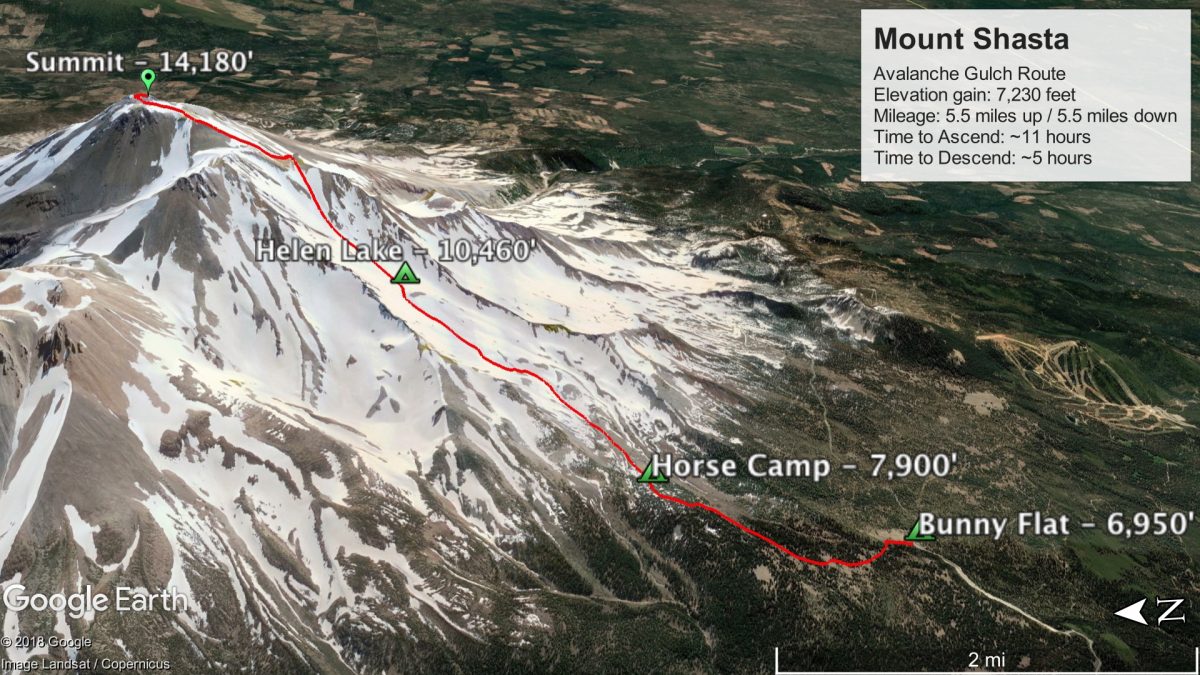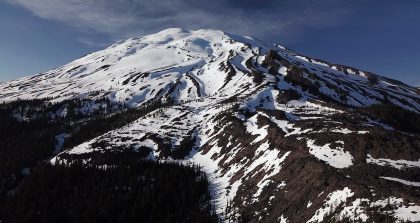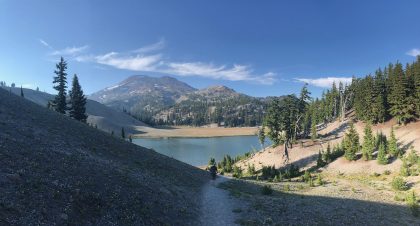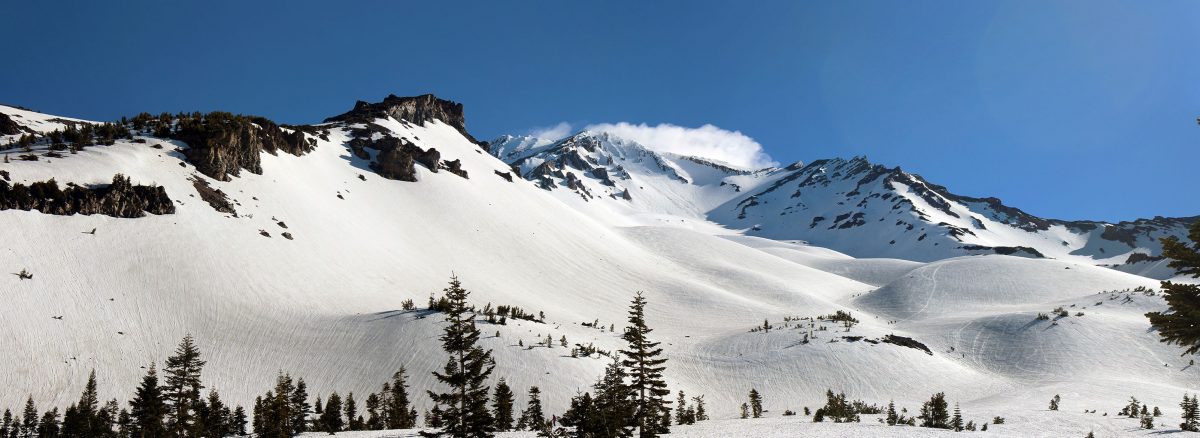
For additional weather information please look at the following resources:
Trailhead Status
Bunny Flat trailhead is recommended for first time climbers and is accessible year-round by motor vehicle.
Road Closures
The USDA reports updates on road status to Bunny Flat trailhead and the surrounding roads:
All climbers should be aware of the elements of risk associated with climbing on Mt. Shasta. While some dangers are more likely to occur during particular seasons it’s important to be familiar with each type and how to avoid, prevent, or mitigate the risk associated.
Rock / Ice Fall
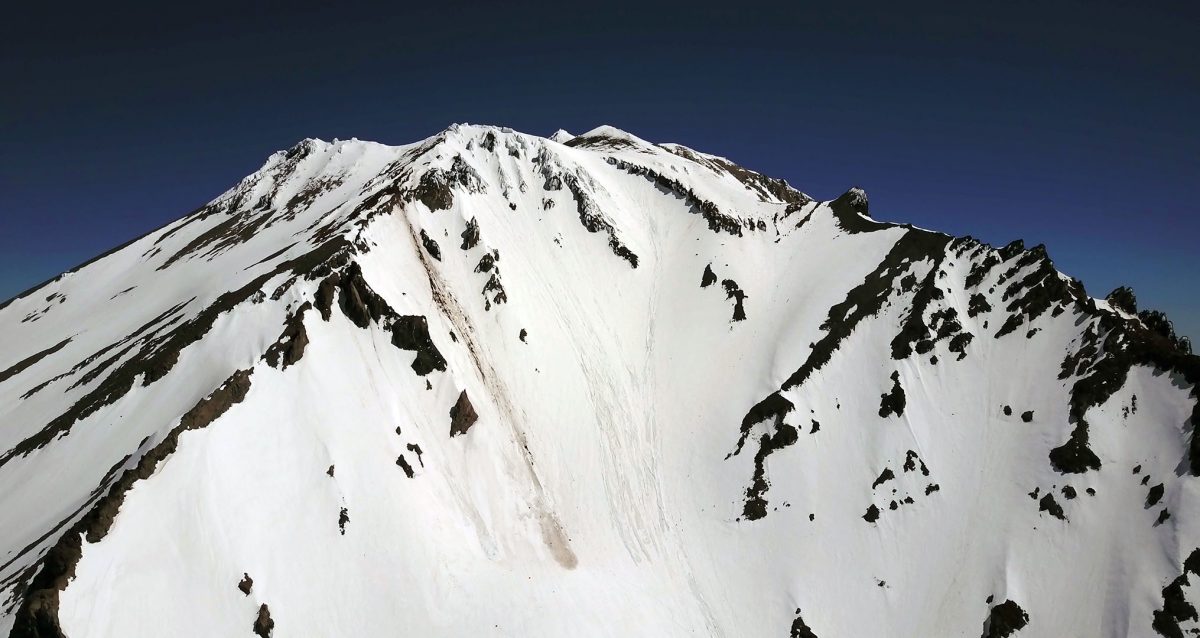
What is it?
- Rock / ice fall occurs when surfaces holding rock, dirt, ice, or snow in place are unable to hold their current formation and begin tumbling down the mountain.
Why does it happen?
- This can be due to the warmth of the sun, strong wind, or vibrations from the earth or other climbers.
- The Cascades are mostly composed of rotten rock piles loosely held together by snow, ice or convenience – in other words, don’t consider the ground beneath the snow and ice to be solid.
When is it likely to occur?
- Rock fall is most common in the Summer and Fall.
- Ice fall is most common in the Winter and Spring.
- Climbers getting an alpine start (12 – 2am) may kick snow and ice loose which can tumble down onto other climbers below.
- In the morning and early afternoon the snow pack becomes increasingly unstable and slushy. Snow, ice and rock are often kicked loose during these hours by returning climbers.
How can it be mitigated?
- Get an alpine start (anytime between 12 – 2 am) and be aware of other climbers above and below you.
- Starting early will help you get up and down the mountain before the sun comes out and the rock / ice fall danger increases.
- Always wear a helmet on the upper slopes of the mountain.
Underestimation
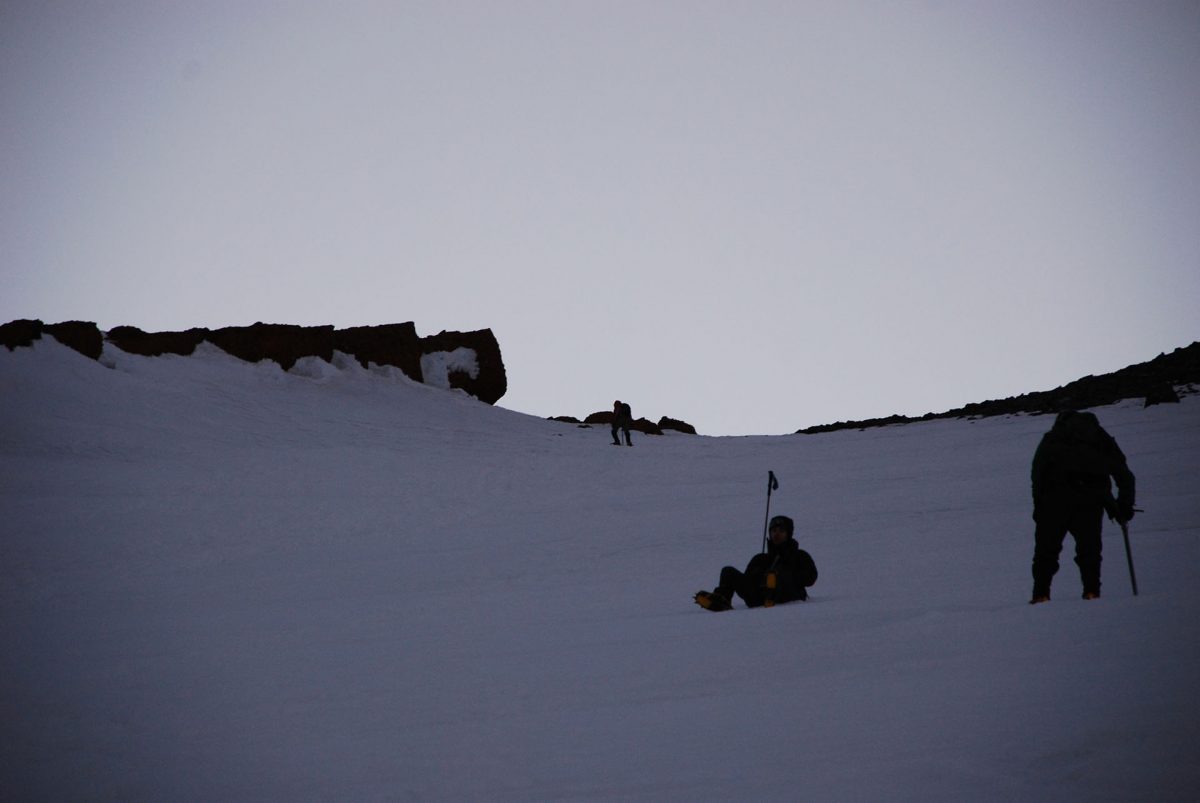
What is it?
- When you’re wearing Mountain Hardwear but you feel like Mountain Softwear.
- Though not an overly technical route, it does follow a 7,000′ vertical ascent that exposes the climber to steep snow and ice, rock fall, and weather extremes.
Why does it happen?
- They might say:”Bro, Shasta City is going to be in the mid-90s this weekend – we should totally walk to the summit of Shasta while we’re there.”
- They could also say: “How ’bout that sweet corn though, bruh?”
- Inappropriate or the absence of specific gear required for a given situation will increase climber risk.
- Lack of knowledge on the use of climbing equipment increases climber risk.
- Lack of ability to properly assess a dangerous situation and/or potential risk increases climber risk.
When is it likely to occur?
- Underestimation is most likely to occur when climbers have neglected to thoroughly understand the risks involved with climbing.
- As with any mountain, conditions can change rapidly at elevation causing increased risk of exposure which climbers may not have prepared for.
How can it be mitigated?
- Climbers should become as knowledgeable as possible about the route, conditions, risks, and up-to-the minute weather patterns on Mt. Shasta prior to a climb.
- Constantly re-assess risk and perceived danger as the climb progresses.
- Proper attire & climbing gear, emergency equipment, backup plans with people not on the mountain.
Other Climbers
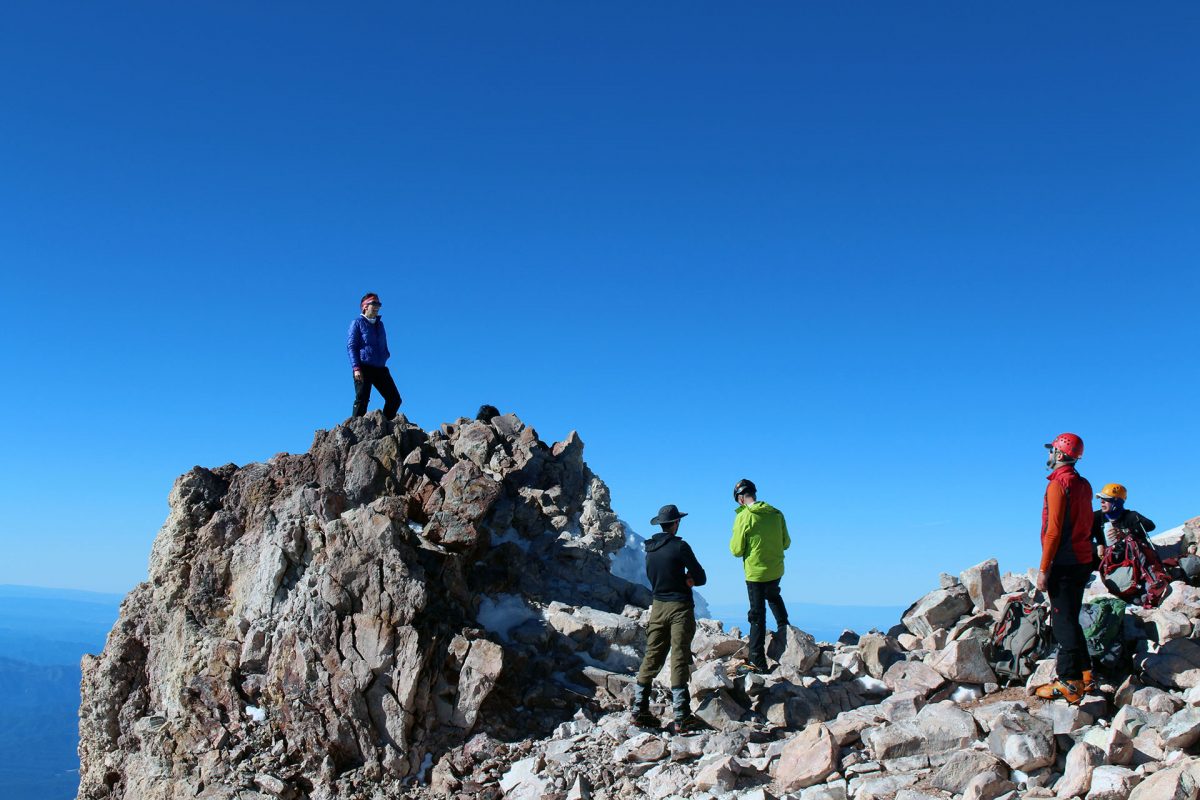
What is it?
- Climbers may pass you quickly, stop in front of you, fall and slide into you, drop debris or equipment, etc. – In other words – Despite your best efforts, other climbers must be taken seriously as a variable of risk.
Why does it happen?
- Improved weather during the Spring and Summer months attracts more climbers – Many more climbers.
- Whenever there are a lot of climbers together in a relatively small area there is the potential for danger.
When is it likely to occur?
- Spring and Summer seasons.
How can it be mitigated?
- Move quickly, carefully and efficiently along the path.
- Yield to uphill traffic while descending.
- Wait behind slower climbers, don’t pass unless they give you the OK.
- Pass quickly and well to the side of other climbers / teams.
- Give other climbers and teams lots of space.
- Travel single file.
- Be patient
- Be polite.
Avalanches
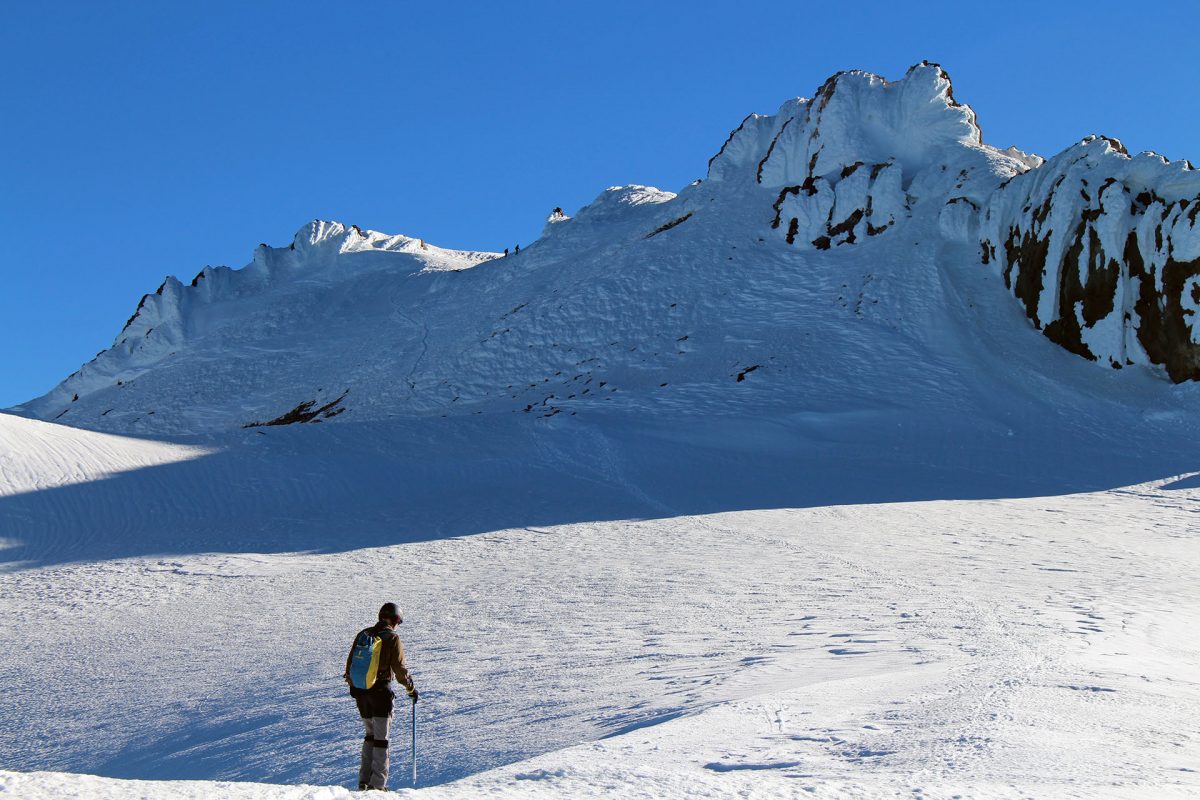
What is it?
- An avalanche is a rapid flow of snow down a sloping surface.
- After being triggered, avalanches can accelerate rapidly and grow in mass and volume as additional snow and debris gets picked up in it’s path.
- Avalanches can only occur in standing snow pack – in other words a significant mass of accumulated snow.
Why does it happen?
- Typically due to a mechanical failure or structural instability of some kind.
- Causes can include: external movement (climbers, wind, earth tremors), temperature (ambient air, sun light), or significant snow / rain fall in a short period of time.
When is it likely to occur?
- Avalanches are more likely to occur when temperatures increase (9am to 3pm) and the snow begins to soften.
- They can also be triggered by your or other climbers.
How can it be mitigated?
- Avalanches are a very real concern on this route, thus the name Avalanche Gulch – Each and every time a climb is attempted avalanche conditions should be assessed.
- After any new snowfall in the spring and summer there needs to be 3-4 days with a combination of temperatures above freezing and sun radiation during the day, followed by temperatures below freezing at night, to stabilize the snow pack and minimize avalanche risk.
- That timeline can be shortened to 36-48 hours if there has been significant rainfall all the way up to the top of the mountain.
- Entire courses are available through REI on how to identify potential avalanche zones and avoid them.
- In the event that an avalanche does happen and you or a fellow climbers are buried there are various pieces of equipment that can increase survivability, such as an avalanche probe
, lightweight, utility shovel
, avalanche transceiver
, or an inflatable backpack
to float on top of the rushing snow.
| Permit | Cost | > 10,000′ | < 10,000′ |
|---|---|---|---|
| Mt. Shasta Summit Pass | $25/person | Yes | No |
| Wilderness Permit | Free | Yes | Yes |
Mt. Shasta Summit Pass
- Required? Yes, above 10,000 feet or above Helen Lake.
- Cost: $25.00 per person.
- Quota: None.
- Use: You must fill in climber information and carry it with you on the day(s) of your climb. Permit is valid for 3 days.
- Where to acquire: Permits can be acquired at the Bunny Flat Trailhead, or the Mount Shasta and McCloud Ranger Stations.
- McCloud Ranger Station is located at 2019 Forest Rd, McCloud, CA 96057.
- Mount Shasta Ranger Station is located at 204 W Alma St., Mount Shasta, CA 96067
Wilderness Permit
- Required? Yes, year round.
- Cost: Free.
- Use: This is a general form stating the people in your party, planned route, climbing dates and emergency contact info. This form is used when you, or someone you know, have contacted authorities and initiated a search for your party. However, if you don’t come back on your stated date, don’t depend on this form to initiate a search for you.
- Where to acquire: In-person/self-register at Mount Shasta, McCloud Ranger Stations, and all trailheads that are open.
Special Restrictions
- Group size: Limited to 10 persons or less.
- Duration: 7 nights within a 30 day period.
- Fires: Wood fires are not permitted, camp stoves with portable fuel canisters are OK.
- Pets: Dogs are not permitted within the Mt. Shasta Wilderness.
Restrictions cited from: USDA.gov.
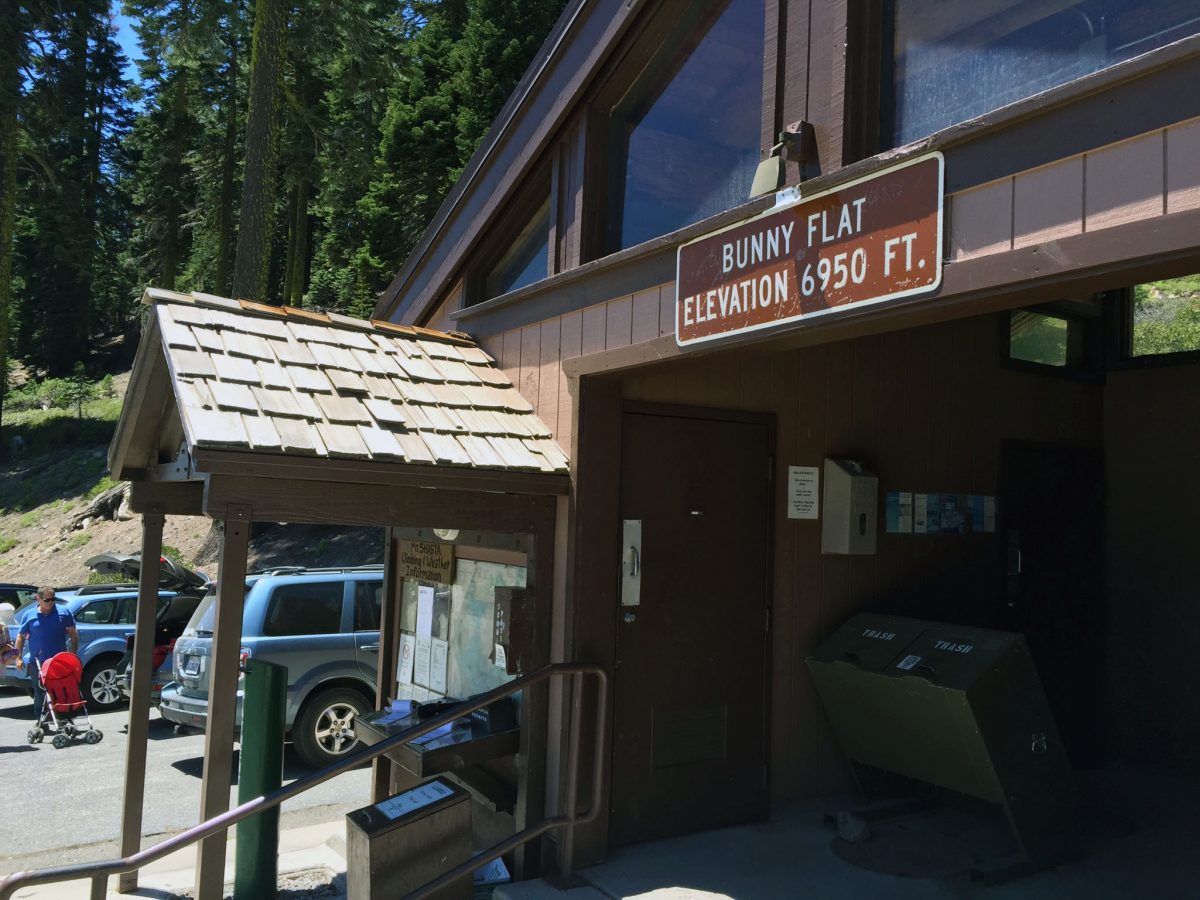
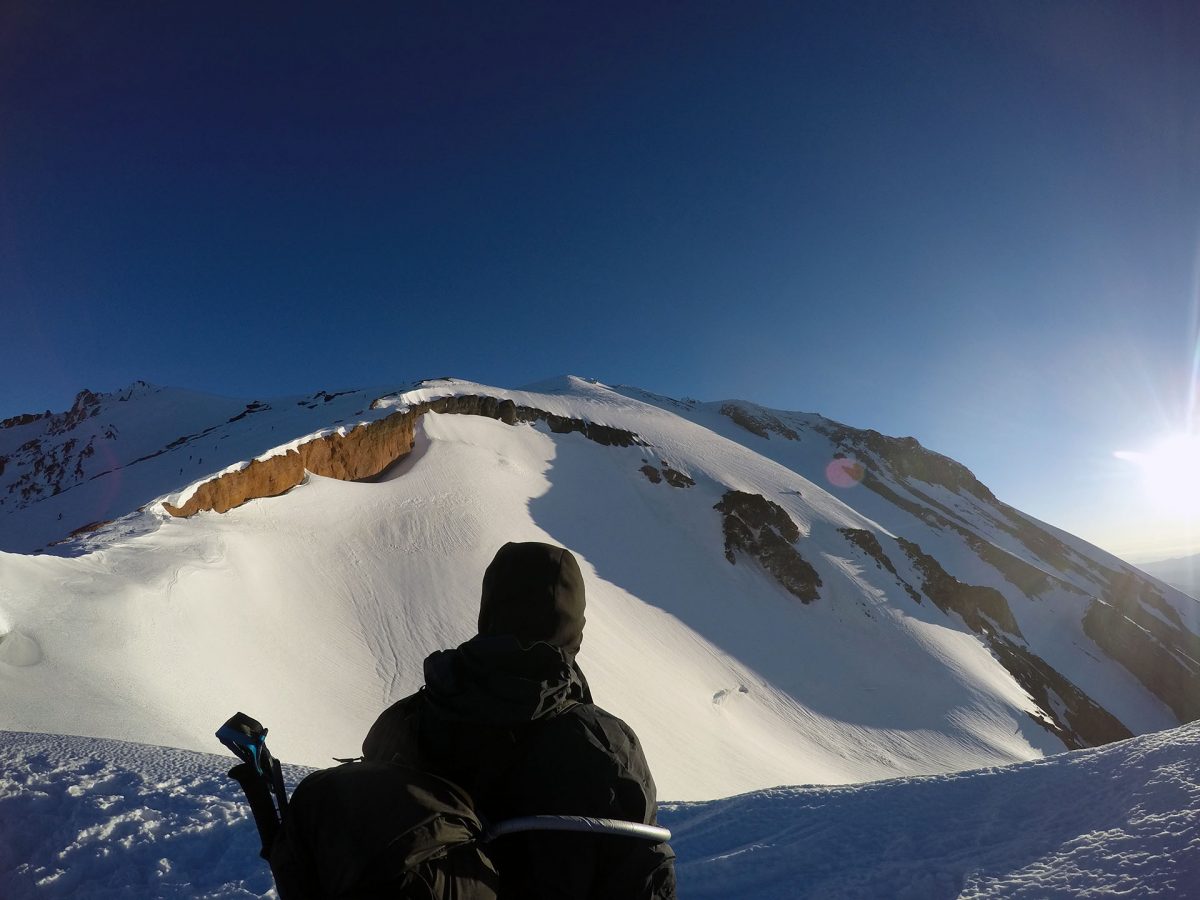
Mt. Shasta is a popular climb for both intermediate and experienced mountaineers. Although strenuous, this non-technical climb is suitable for people in good physical condition who are comfortable with climbing at elevations above 10,000 feet.
Because climbing is a physically demanding activity many people will train to climb Mt. Shasta by going on several training hikes. Training hikes should consist of elevation gains of 5,000 – 7,000 feet and distances of 8-12 miles to simulate the slope of Mt. Shasta. Climbing other mountains like Mt. Adams, Mt. Hood, or Mt. Whitney will give you an idea of what it’s like to climb at elevation. If going on less challenging local hikes, carry the equipment you will climb with. If you do not own all the equipment you will need, put other items in to simulate weight. A pack of 20-30 pounds is average for a Mt. Shasta overnight climb.
A person who exercises regularly and is in good physical health should plan on doing 4-6 of these sorts of hikes before a climb and have climbed at least 1-2 smaller mountains. Those who do not get regular exercise or have other health problems should consult their doctor for an exercise routine appropriate for them, and slowly add in hikes with elevation and a weighted pack.
Winter conditions transform the mountain from a rock scramble to a more traditional snow traverse. When climbing on snow every climber should be trained and practiced in self arrest and crampon techniques. These are skills you will need for a winter climb. It is also important that each climber is familiar with other skills that conditions may require, for example: avalanche condition assessment, avalanche transceiver use, first aid and navigation. Be prepared with layered clothing to withstand sub-freezing temperatures and high winds at elevation during a winter climber. Remember that the safety of every climber on the mountain is at risk whenever a single climber is unprepared.
Avalanche Gulch
December, 1947 – “I don’t know how to turn,” said Leonard Yaekle before leaning forward on his skis and making history as the first descent from the summit of Shasta on something other than crampons. According to Fletcher Hoyt, “[He] went straight down the mountain! I wasn’t used to that myself, but I gave it a try… When I got down to Helen Lake I knew I was going to live – that’s the last time I tried that!”
Avalanche Gulch was the route traversed by Hoyt and Yaekle on that cold December day. Starting from Bunny Flat trailhead, it is the most active climbing route on Mt. Shasta today. Overall it is one of the easiest to climb and achieves peak popularity during the spring and summer months. The climb can be completed in a day, but most climbers opt to camp overnight at a handful of established camp sites to acclimate and take in the alpine view.
In this section of the guide we will outline what a typical 2 day climbing itinerary might look like to summit Shasta via Avalanche Gulch.
A typical schedule for a 2-day climb of Mt. Shasta along the Avalanche Gulch route might look like this:
Day 1
- 8:30 AM – Arrive at Bunny Flat trailhead (6,950′).
- Check in, purchase summit pass, organize gear and use the restroom.
- 9:00 AM – Depart the parking area.
- 11:00 AM – Arrive at Horse Camp / Sierra Club Cabin (7,900’).
- Take a break – Eat a snack, fill up water containers from natural water source.
- 1:30 PM – Reach 50/50 Flat (9,482′).
- Take a break – Check weather and visibility.
- If either is poor consider waiting for better conditions, or turning around.
- 3:00 PM – Arrive at Helen Lake (10,460’).
- Setup camp & rest.
- Melt snow for water.
- Eat food, drink water.
Day 2
- 2:00 AM – Wake up.
- Prepare a high calorie breakfast.
- Pre-hydrate with at least a liter of water.
- Prepare gear – We recommend you start with crampons, helmet, and ice axe/trekking poles.
- 3:00 AM – Depart from Helen Lake.
- 6:00 AM – Arrive at the top of Red Banks (12,850′).
- Take a break – Eat food, drink water.
- Evaluate weather conditions – If weather is deteriorating, consider going back down.
- Evaluate climber conditions – If anyone is experience altitude sickness they should stop here.
- 7:30 AM – Arrive at the top of Misery Hill (13,800′).
- Take a break – Eat food, drink water.
- The summit is in view!
- 8:10 AM – Arrive at Summit (14,180′).
- Take pictures, eat snacks, drink water, enjoy!
- 9:00 AM – Depart from Summit.
- 11:15 AM – Arrive back at Helen Lake.
- Pack up camp.
- Eat lunch & rehydrate.
- Prepare for a slushy return trip (seasonal).
- 2:00 PM – Arrive back at Bunny Flat trailhead.
Day 1 – Ascent
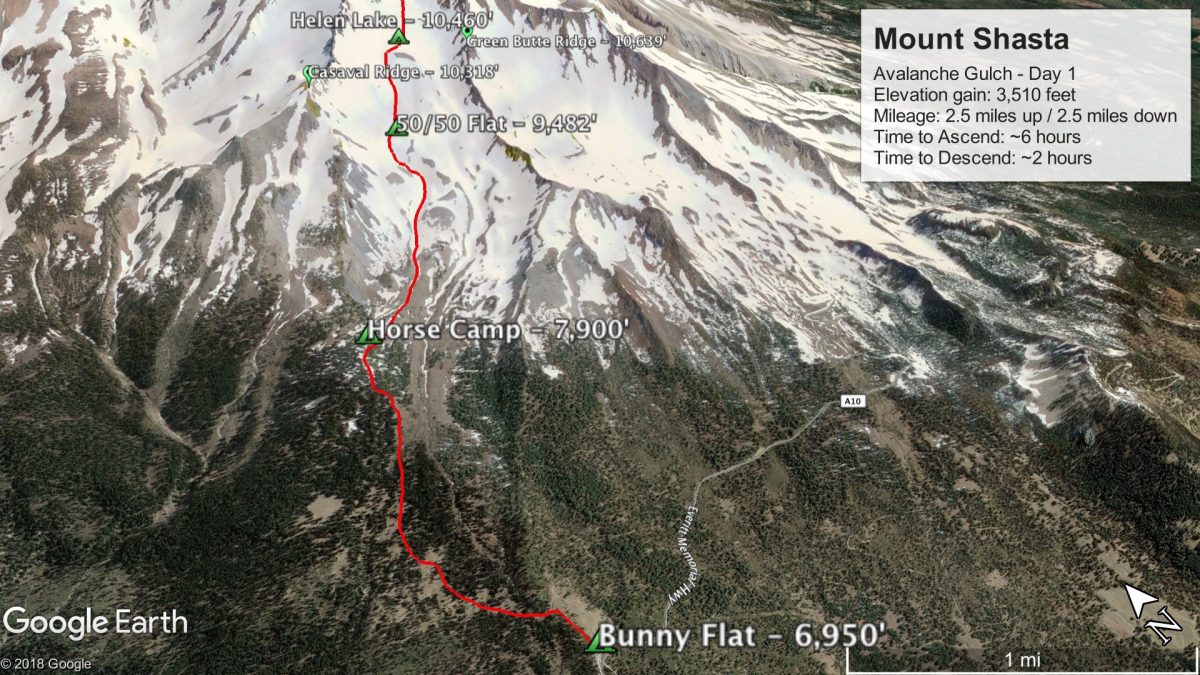
The town of Shasta (3,500′) sits just off of the interstate 5 freeway and, if you’re visiting Mt. Shasta during the Spring or Summer, you may remark at how warm it is. Another 3,500 feet up at Bunny Flat trailhead (6,950′) it may still be sunny but the increase in elevation will add a slight chill to the breeze, there may even still be snow left over from the last storm that rolled through. Regardless, it will be humming with people either out camping, day hiking, or getting ready to climb Mt. Shasta.
Bunny Flat is where you will fill out and submit a wilderness permit form. Mt. Shasta Summit passes can also be filled out here and $25 deposited in a payment tube. Here you can arrange your gear, deposit trash, use bathrooms, and organize your climbing party.
It’s best to get here in the morning before the crowds arrive and also to avoid most of the afternoon melt. We recommend arriving at Bunny Flat at 8:30am and departing for the Horse Camp at 9:00am
The 1.5 mile hike to the Horse Camp (7,900′) may be snow covered or it may be a more traditional dirt/sand/rock trek. We really liked Columbia’s Peakfreak XCRSN II Xcel hiking boot for this section of the hike because of it’s light weight, aggressive tread, and breathable yet waterproofed materials. While some in our group trudged through the dirt in their solid-soled climbing boots those that opted for standard hiking boots glided effortlessly along and their feet would be thanking them later.
After a few hours the forest will start to open up signaling your arrival at the timberline-located Horse Camp which is owned by the Sierra Club Foundation. If the cabin/lodge is open you can sign the guest register, peruse a small library of mountain books, and chat with the caretakers. The site has a lost and found, a natural water source, and an environmentally friendly toilet system. Some climbers do use this site to setup camp if they do not want to haul their gear the additional 2,500′ up to Helen Lake (10,460′). However it does mean an earlier alpine start.
The Horse Camp is a great place to take a break, eat a snack, drink some water, and enjoy shade under the remaining trees before experiencing the full exposure of the mountain.
More experienced Shasta climbers may opt to ascend via Casaval Ridge to the left of Avalanche Gulch. You may see parties of climbers departing the Horse Camp in this direction, but the more established path will be straight up through the large valley that sits before you.
Progress will begin to feel slow. The incline will begin to increase steadily. The body is also now starting to experience thinner air and, depending on weather, you may have to deal with the opposite extremes of cold sharp winds or stifling heat via overhead sun exposure. The key is to keep moving but avoid overheating. Time breaks appropriately in order to catch your breath.
The 50/50 Flat (9,482′) has no markers or designations indicating its existence. In fact, it may not seem very flat in most areas but if you scout around there are a couple good spots to pitch a tent or bivvy. For most climbers this is a good place to take a break before the final push to Helen Lake to setup camp for the night. For climbers who are losing day light or feeling too exhausted to push on to Helen Lake this may be a good location to setup basecamp. Another reason you might camp here is to avoid the tent city that can form at Helen Lake.
If you followed our itinerary, you should arrive at Helen Lake (10,460′) by about mid-afternoon. By this point you will likely be feeling the affects of the thinner air. Take a load off and grab a snack or fix a meal. Force yourself to drink water and snack even if you don’t feel hungry or thirsty. Even mild acute mountain sickness (AMS), or elevation sickness, can mask feelings of hunger or thirst. Left un-checked this can leave your body feeling weak on summit day.
Setup camp and settle in for the evening. If you opted to carry less water up to save weight and had plans to melt snow to replenish your containers this is a great time to do it.
Enjoy your time here – Helen Lake offers a unique experience as a tiny, final outpost of civilization before the final trek up to Shasta’s summit.
Day 2 – Summit & Descent
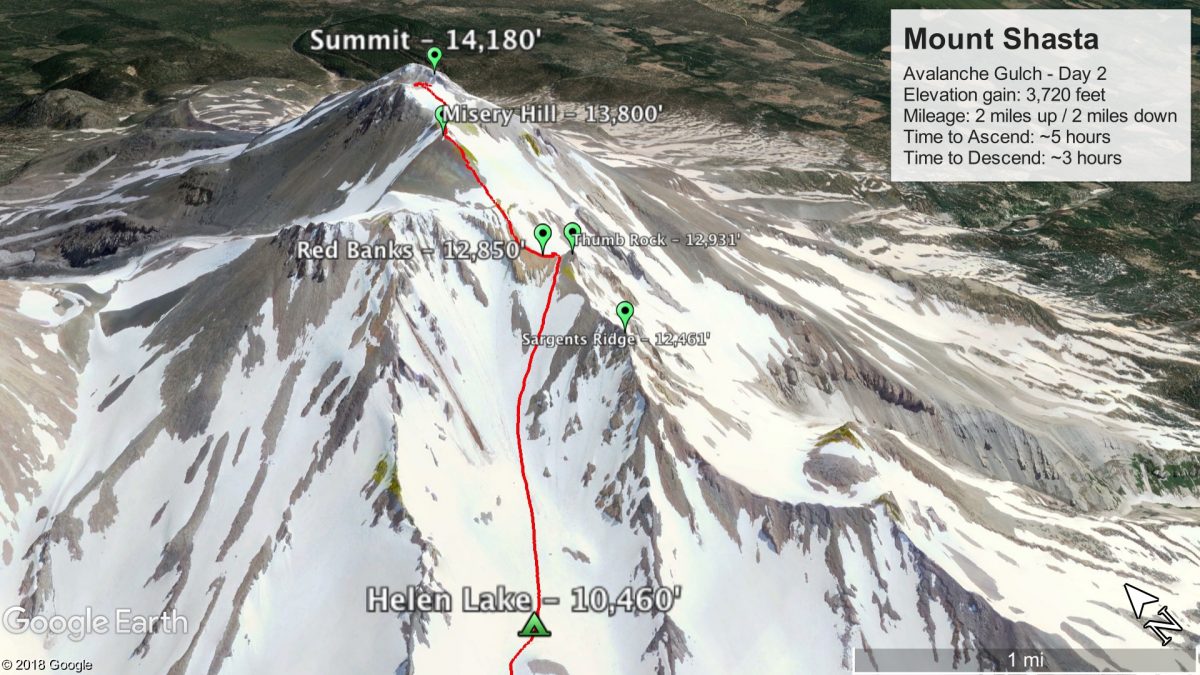
2:00am, wake up – It will be dark and cold; you won’t want to leave your sleeping bag. Depending on your overall fitness level, the first signs of soreness might be starting to kick in. Combine that with whatever weird high elevation dreams you may have been having and it’s going to be a struggle to leave the tent.
The first step should be to eat or drink something warm – this will do wonders for your overall psyche and mood. You’re going to need to wrestle up the motivation to climb another 3,700 feet over 2 miles of rock and ice in them middle of the night. If your body isn’t used to this kind of environment, you will need to force yourself to eat and drink. To stave off dehydration and elevation sickness we recommend consuming at least a liter of water before leaving camp combined with a high (400-600) calorie meal. This isn’t the time to diet. Your body has been and will continue to burn a tremendous amount of energy climbing and keeping the vital bits of your body warm.
Prepare your gear – Fortunately, for summit day, you can travel light. That means primarily carrying around 2 -3 liters of water, 1,500 – 2,000 calories in snacks, and any supporting gear you think you’ll need. Crampons, ice axe, and helmet are required. Since it’s the middle of the night you will want to wear a headlamp.
The climb up to the Red Banks will feel like a very long and monotonous, half-awake trek but as you near the top, and the sun begins to peak out over the horizon, you will be greeted with one of the most epic mountain shadows imaginable. Many climbers rest at the base of the snow packed Thumb Rock, which acts as a plateau between Red Banks and the start of the climb up Misery Hill. It’s a great time to stop for food and water while enjoying the sunrise.
Misery Hill will test your patience and will to climb. It’s only 1,000 feet but it will feel like twice that, especially if the snow pack has melted and you’re left scrambling on rock. By this point you have crossed over the 13,000 foot threshold and breathing will become noticeably more difficult. Take your time on this part and keep reminding yourself that you’re almost there.
As soon as you step over the crest of Misery Hill, one of the most beautiful sights on Shasta comes into full focus – the summit. Across a short plateau of snow the summit will look down at you like a medieval tower. By this point, the excitement and surge of success will carry you the last 380 feet to the top. Savor it!
Descending from the summit back to Bunny Flat will take you approximately half the total hiking time it took you to summit. If you reached the summit in 11-12 hours it may take you 5-6 hours to get back. In general, you will be tired and using a whole new set of muscles, and if the trail is composed of scree and rock progress will be slow. The good news is gravity will be on your side, and there will be far fewer breaks. Descending requires some care on your part and an awareness of those around you, especially heading down from Red Pass to Helen Lake.
An important note – The very top of Avalanche Gulch, starting at Red Pass should not be glissaded on. The grade can be so steep in some areas that you may not be able to stop yourself, even with an ice ax. Keep your ears and eyes open in the event that someone above you falls or calls out a potential rock or ice fall coming your way.
Generally you should descend the route that you came up. Under good conditions the path back will have been paved by the foot steps of other climbers. In situations where visibility is low or fresh snow begins falling it’s always a good idea to have a backup method for navigation, such as a GPS device or map and compass as well as knowledge on how to use both.
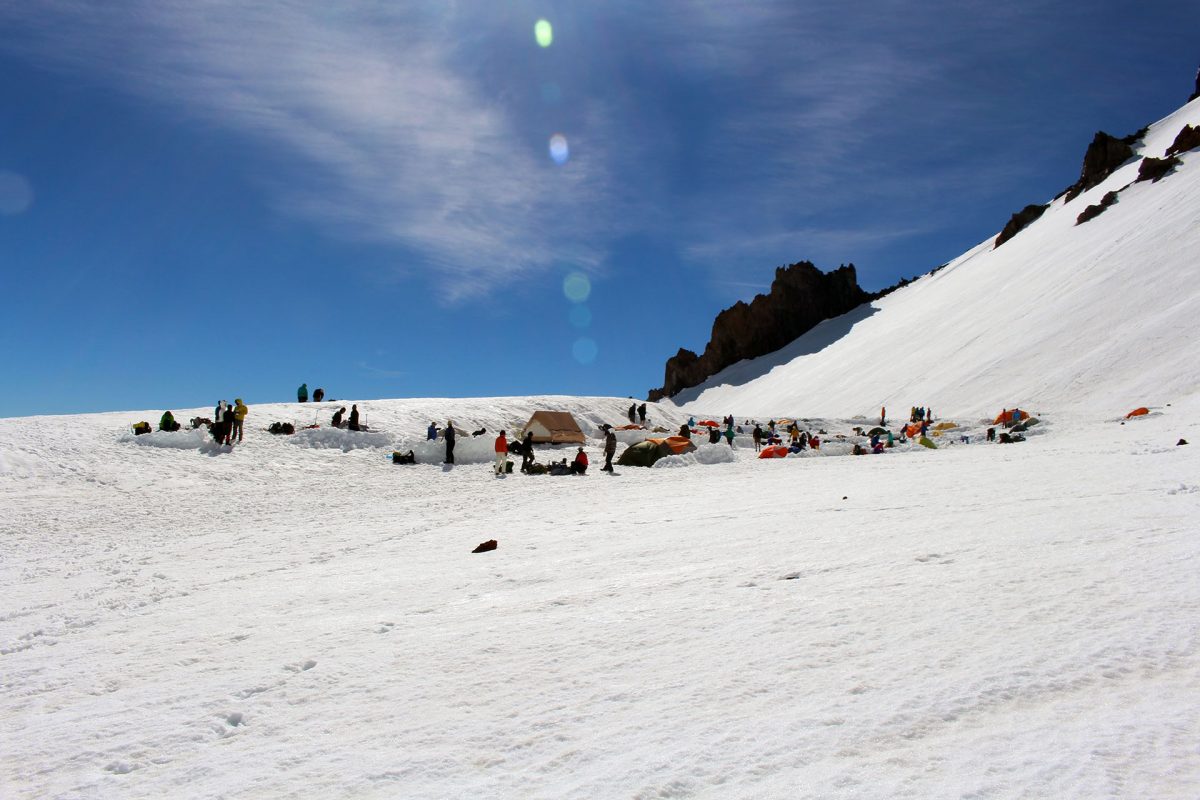
Mt. Shasta can be climbed any time of year depending on your chosen route and weather. However, climbers looking for the best window to summit should plan on climbing from May to October. Picking a date to climb all depends on your preference and risk tolerance. Questions to ask yourself:
- Do you want to climb on rock or snow?
- Do you want isolation or a more populated climbing route?
- Do you want to carry more or less gear during the climb?
- Are you prepared for hot/cold, wet/dry or clear/cloudy weather?
Average Temperature (°F)
Source for climate data is Old Ski Bowl Weather Station (MSSKI) located at 7,600′ via MesoWest & SynopticLabs API. A date range of 1/2013 – 12/2017 was used to calculate monthly average, minimum, and maximum values.
Average Precipitation (in.)
Source for climate data is Old Ski Bowl Weather Station (MSSKI) located at 7,600′ via MesoWest & SynopticLabs API. A date range of 1/2013 – 12/2017 was used to calculate monthly average, minimum, and maximum values.
Three outfitter/guide businesses are under permit with the Forest Service to guide climbing trips on Mt. Shasta:
Source: USDA.gov
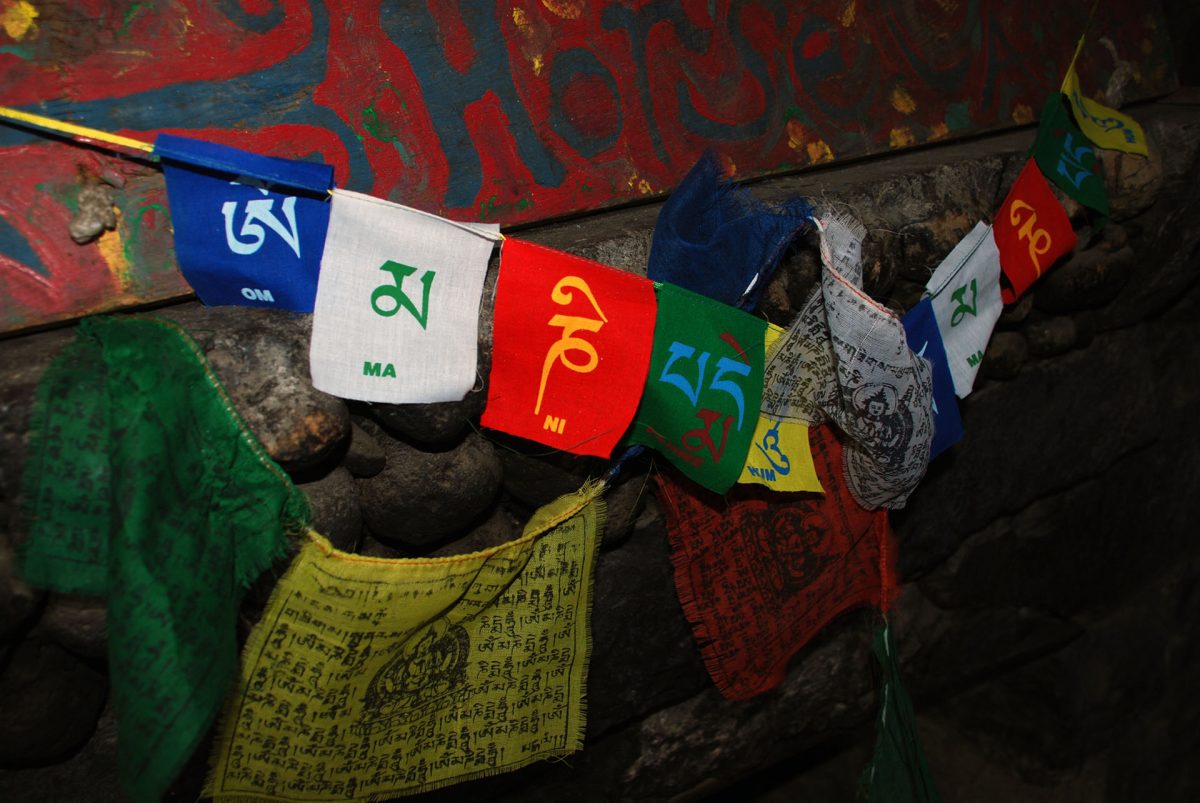
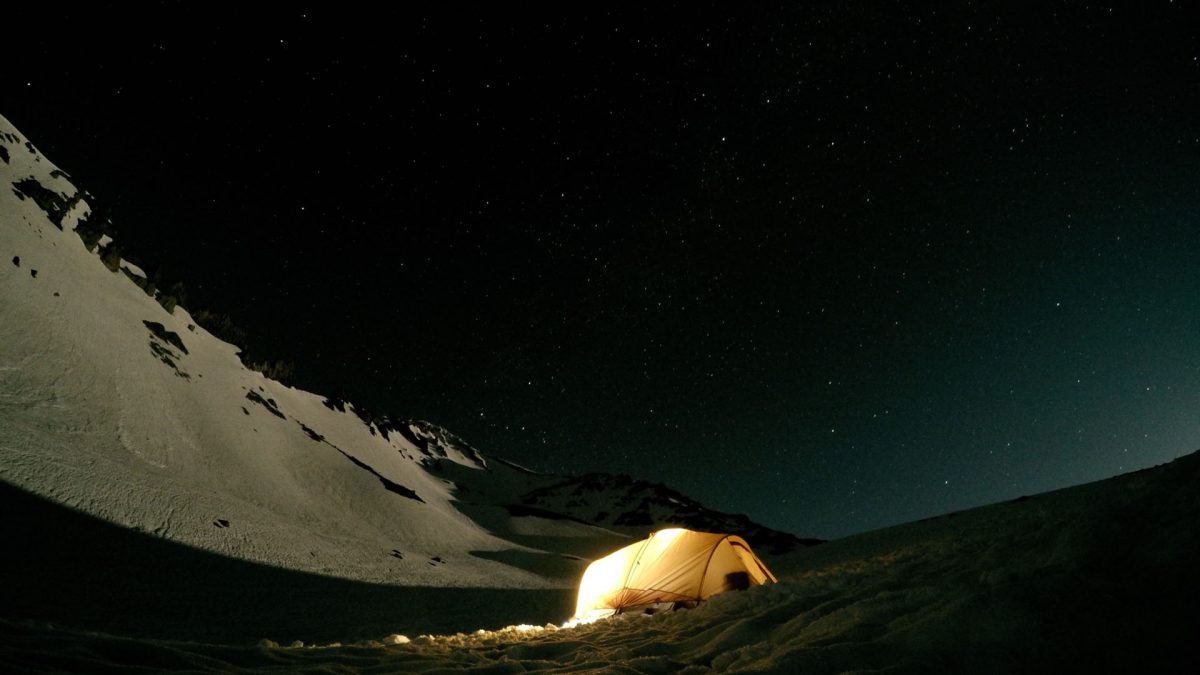
Camping
Many climbers may opt to climb Mt. Shasta in the standard 2-day window, but some climbers may choose a shorter or longer stay on the mountain. Regardless of your intended timeline there are plenty of locations to setup camp. In fact, there are four major spots where climbers setup camp:
- Helen Lake – The most popular location for climbers looking for a base camp roughly halfway up the mountain. In the spring and on days with good weather this location becomes a tent city. The rule is first-come, first-served. There are no toilets or water-sources at Helen Lake so please practice good camping etiquette. If you pack it in, then pack it out.
- 50/50 Flat – For climbers wanting a bit more solitude from the masses, camping roughly 1,000′ below Helen Lake might make more sense. This area generally has a few flat spots to setup a small tent or bivy. Be sure you are off the main climbing route or you might have hordes of climbers sifting through your camp.
- Horse Camp – The last established outpost of civilization on this route, the Horse Camp sits on the edge of timberline and offers several forested, established camp sites. Camping fees are $5.00 per tent and $3.00 per solo bivy. The suggested day-use donation is $1.00. The camp has a composting toilet and a spring which are not maintained during the winter months but offer climbers a last chance to use an enclosed toilet and fill up water containers.
- Bunny Flat – For climbers who have traveled long-distances to get here, the Bunny Flat trail head may be the best place to rest up and start climbing fresh the next day. This location has many dispersed camp sites on the south side of the road. which first-come, first-served and do not have a fee.
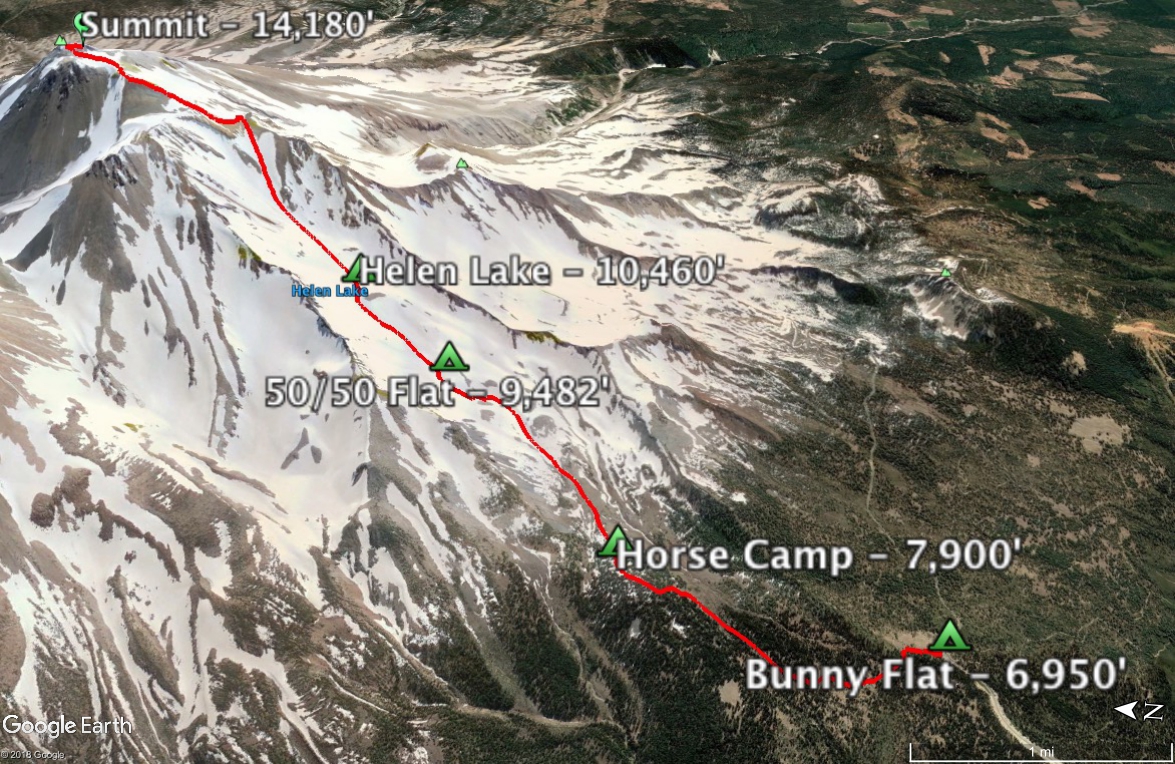
If you are concerned about finding a place to camp on the mountain, no need to worry. The road up to Bunny Flat trail head, Everitt Memorial Hwy/Sand Flat Rd, has many camping opportunities that are only minutes away from the trail head.
Lodging
The nearby town of Mount Shasta, CA has at least a dozen different hotels, inns, and B&Bs. Other lodging options might be found on AirBnB. The town of Mount Shasta, CA is only 20 minutes drive from Bunny Flat Trailhead.
Mt. Shasta is located in Northern California just 12 miles off of interstate 5, making it one of the most easily accessible mountains in the country.
Here are a few one-way driving time estimates from major cities:
- Portland, OR: ~6 hours
- Sacramento, CA: ~3.5 hours
- Reno, NV: ~4 hours
- Salt Lake City, UT: ~11.5 hours
- Boise, ID: ~8.5 hours
| Required | Recommended | Optional |
|---|---|---|
| Clothing | Overnight Gear | Avalanche Recovery Gear |
| Food | Stove | Shovel |
| Water | Head Lamp | |
| Crampons | Gaiters | |
| Ice Axe | Trekking Poles | |
| Helmet | Navigation | |
| Blue Bags | Mobile Device | |
| First Aid Kit | Sun Protection |
Many climbers may find gear selection to be subjective. Our gear recommendations are based on a well-rounded approach to mountaineering on Mt Shasta in the spring season with the objective of maintaining the least amount of risk and while retaining minimal weight. Required items are a must for any climber. Recommended items should be strongly considered and may even be required depending on if you attempt to stay overnight on the mountain. Optional gear should be included based on season and weather. You should always evaluate what gear to bring based on current conditions and your overall risk comfort level.
Clothing
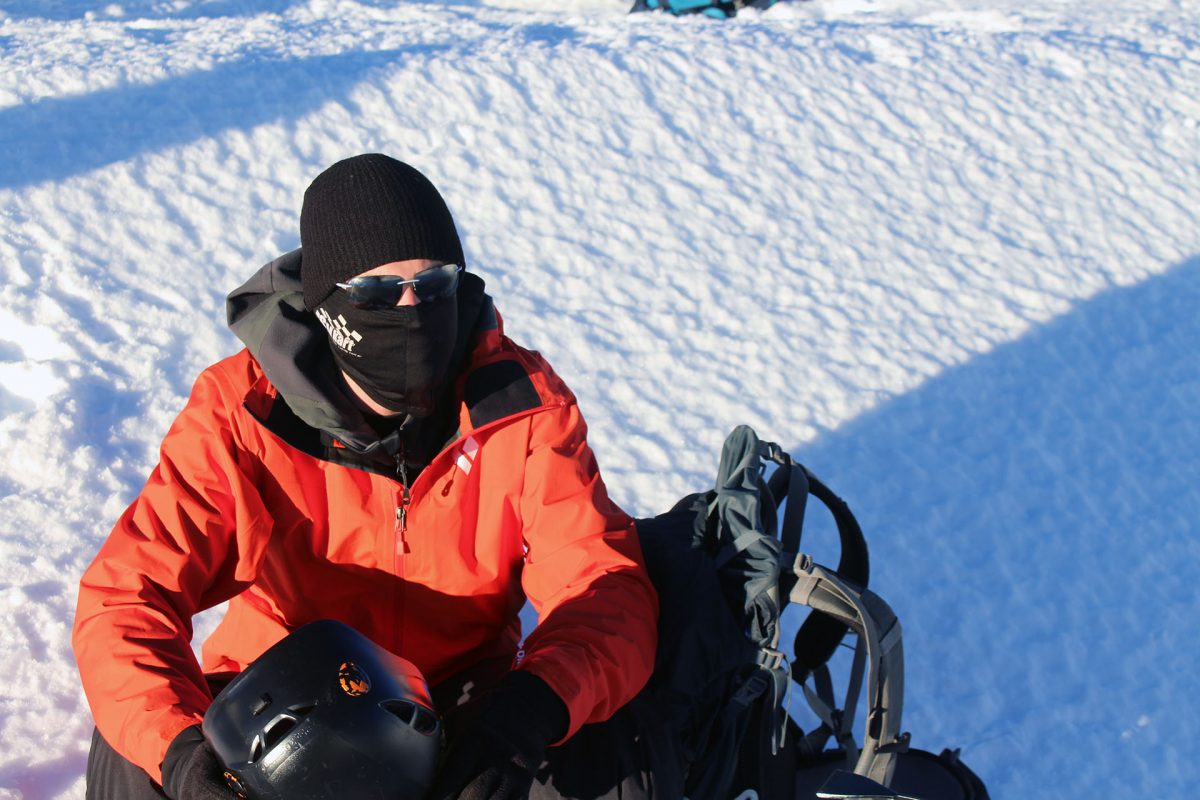
Mt. Shasta, like most peaks, can be unforgiving to those who neglect a basic layering system designed to combat the rapid changes in temperature, precipitation and wind. The wide range of climate possibilities should determine your clothing strategy on the day of the climb.
The best approach for Mt Shasta is the 4-layer system: Base-layer, mid-layer, shell. Do not wear cotton – All layers should be either synthetic, wool, down or another breathable material.
Base-layer – Top and Bottom – This can best be defined as a long-sleeve compression shirt and synthetic leggings
. Your base layer should allow for a great range of mobility, be moisture wicking and fast-drying, but also ultra-warm and breathable.
Mid-layer – Top and Bottom – Also known as the soft shell layer, this is the layer you should be able to climb in under ideal weather conditions. Similar to the base layer these items should maintain optimal breath-ability, heat/moisture dissipation, and retain adequate warmth. For example, this might be a fleece jacket and hiking pants
.
Shell – Top and Bottom – This is the layer you put over everything else. While it may not provide much insulation, it’s primary purpose is to keep wind, rain, sleet, snow, ice, and any other undesirable elements away from your underlying layers. An affordable shell layer might be the Adidas Outdoor Wandertag jacket and O’Neill Hammer snow pants
. A shell layer with more advanced, light-weight, protective materials might be the Black Diamond shell jacket
or Arc’teryx Beta AR jacket
and Mountain Hardware Torsun pants
.
Insulation – This is your deep cold layer and is typically only required for a winter climb or a particularly cold night. It comes in to play when conditions start getting chilly or you are not moving enough to maintain a comfortable body temperature. This is typically a down jacket (aka the puffy jacket). We personally like and have used the Black Diamond Cold Forge Parka and the Arc’teryx Thorium SV hoody.
Gloves / mittens – Durable gloves are recommended when climbing on exposed rock. When it’s colder we like to use a fleece glove or liner. In the winter these can be paired with a deep cold mitten. In most conditions you will find that your hands retain quite a bit of warmth with a decent fleece glove and that the mittens function as a great backup for when the wind picks up or the weather degrades. Why mittens? Because by not separating your fingers from one another in a traditional glove they stay warmer by sharing their heat. The REI fleece grip gloves paired with the basic cold weather mitten are a fantastic combination in most conditions. A similar combo is offered by Outdoor Research with their fleece gloves and Meteor mitts
.
Hats – Fact: The majority of heat loss occurs through the top of your head. A wide-bill trucker hat may give you “bro” points, but it retains minimal heat. Beanies or other insulated head gear is the recommended choice.
Balaclava – Not to be confused with the Greek dessert (baklava), a balaclava is like a ski mask which protects the exposed parts of your face to the elements. You would be surprised at how much of an improvement even an inexpensive balaclava will make in cold or windy conditions.
Boots – A quality pair of boots can make or break a successful summit attempt. Considering the amount of abuse that your feet will experience on this climb, selecting a boot that is both comfortable and supportive is crucial. Depending on conditions, this may mean packing two pairs of boots: a climbing boot, such as the La Sportiva Trango mountaineering boot, and a hiking boot, such as the Columbia Peakfreak Outdry hiking boot
. If you are packing crampons you will also need a boot which is compatible with your chosen style of crampons.
Socks – Arguably one of the most important selections behind boots. Your feet will be taking a beating during the climb and ensuring that they stay warm, dry and comfortable is a primary factor in having a successful summit. Long wool socks are highly recommended.
Eye protection – Depending on the wind speed, having a decent pair of ski goggles to protect your vision can help you focus on the path ahead. On clear, sunny days having a sturdy pair of sun glasses can prevent damages to your eyes and also prevent snow blindness in the winter.
Food
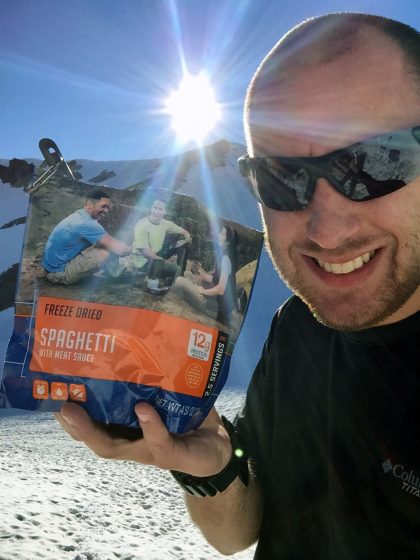
Eat before, during, and after the climb. Load up on fats and proteins before the climb as these metabolize more slowly and will give you energy for a longer period.
During the climb snack every 20-30 minutes on high carbohydrate foods as these metabolize faster and give you quick bursts of energy. Eating at least one or two snacks per hour avoids large spikes in energy and helps maintain smooth, consistent energy levels. Keep in mind, roughly 50-100 calories can be burned every 15 minutes depending on your base metabolic rate, speed, grade, and air temperature. In the winter, the body will burn additional calories just trying to stay warm. For a 9 hour climb that’s somewhere between 1800 – 3600 calories. That’s the equivalent of between 8 – 17 regular sized Snickers bars, which apparently you can buy in bulk.
It’s also important to be aware that your taste buds may change as you gain elevation. Furthermore, altitude sickness may actually suppress appetite. In other words, if you only sort of liked a food at base elevation you’re probably not going to like it at high elevation. So bring foods that you know you’ll enjoy. I like sour gummy worms for high elevation expeditions.
After the climb, have a burger, sandwich or something high in fats and protein which helps muscles recover from lots of exercise. Remember your metabolism keeps going for an hour or two after you stop, so that’s the time to binge a little.
Water
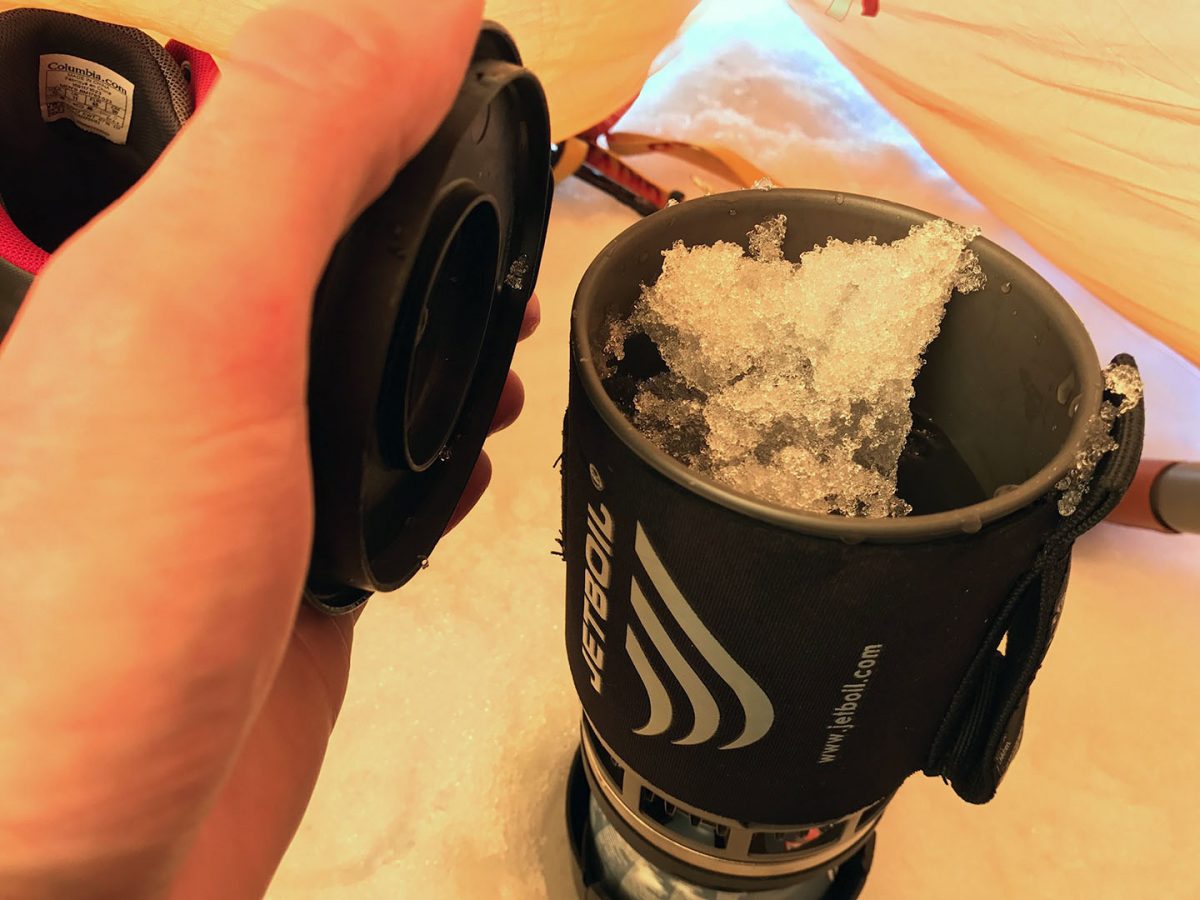
Science recommends 1 liter of water be consumed for every hour of high energy activity. For this climb that would be 12 – 16 liters (or 3 – 4 gallons), which is the equivalent of 25 – 33 pounds of weight on top of all the other gear you would be carrying.
Similar to food – we recommend the before/during/after strategy. Drink 2-4 liters of water a few hours before you start your climb to saturate your body and reach your muscles. For the actual climb, bring 2-4 liters of water to sip on constantly. While a bladder makes constant hydration easier, we recommend Survivor Filter collapsible canteens for their light-weight and compact size when not full or CamelBak water bottles
to avoid the scenario where your bladder hose freezes preventing you from drinking any water. If camping overnight, Camelbak bottles also offer a usable container for storing melted snow water. If you do use a bladder, blow water back into the bladder to help prevent the hose from freezing or purchase a hose insulating layer. Another option would be to have a hybrid water bottle and bladder system in case either method fails. After the climb, have a gallon of water waiting in the car to replenish your reserves.
Crampons
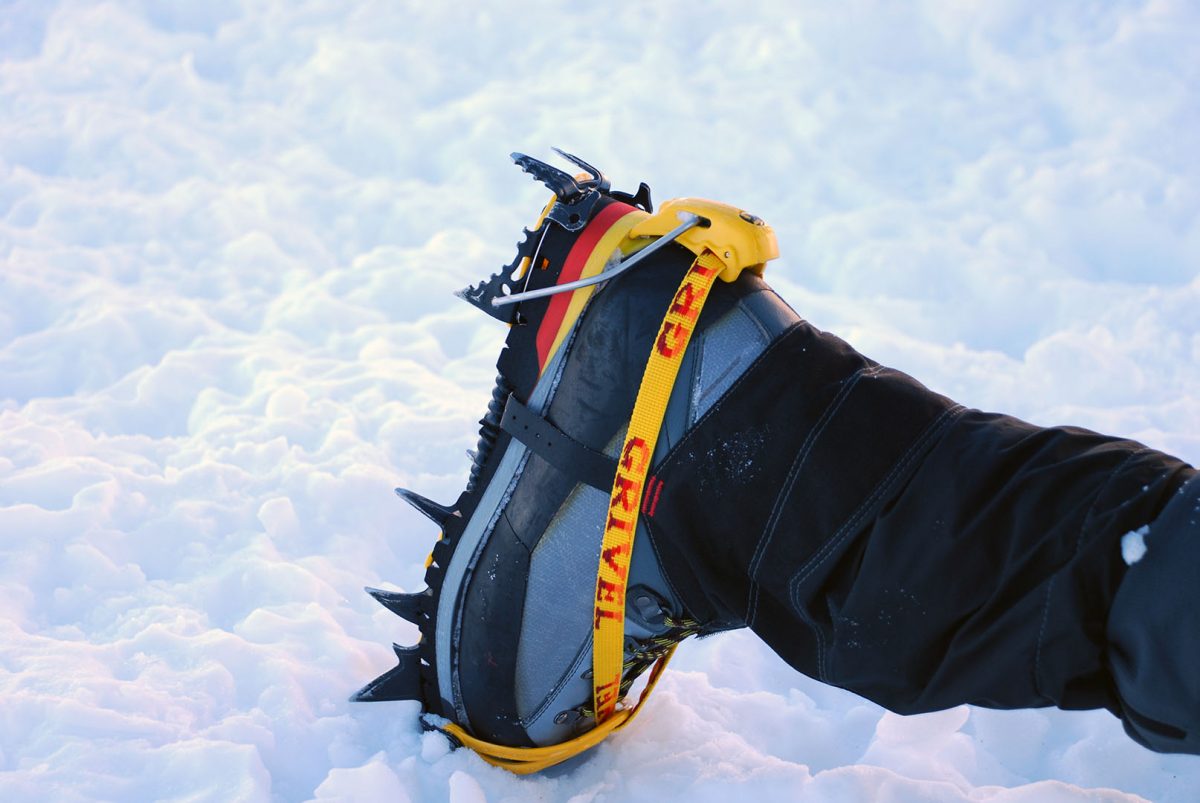
Crampons allow you to grip into solid snow and ice providing stability and traction when you need it most. They are only truly needed when traction on ice and snow is required.
There are several types of crampons available on the market, but the key is matching the correct crampon binding system to your boot. In fact, REI has a great article describing how to choose the best crampons for your goals.
We highly recommend you pick your boot prior to selecting a crampon because at the end of the day a comfortable, supportive boot is preferable to ill-fitting footwear that you’ve attached some spikes to. One pairing that we’ve had a lot of success with is the La Sportiva Trango boot and Grivel G-12 new-matic
crampons. Grivel’s new-matic system has a locking point in the rear and straps in the front to ensure a secure fit to this style of boot.
Ice Axe
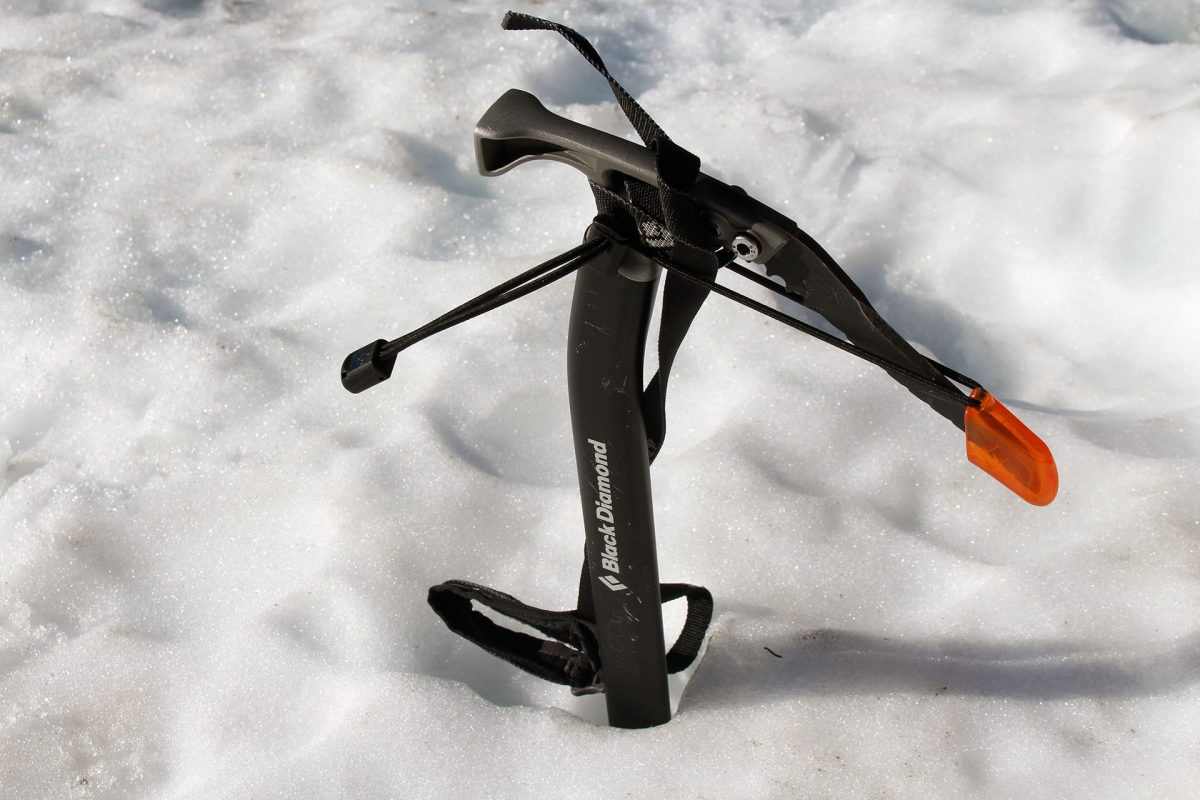
Acquiring and carrying an ice axe is easy, but knowing how to use it requires skill, familiarity and practice in the art of self arrest. The Avalanche Gulch route is not technical so we recommend a straight (or slightly curved) handled ax.
When choosing the length of an ax, stand up straight and hold the ax by your side grasping its head between your fingers. The spike (bottom) of the axe should rest by your ankle. A longer ax might be nice as Mt. Shasta’s Avalanche Gulch route is relatively low angle. A shorter ax will require you to bend over to place it, a tiring endeavor. Also, a shorter ax may seem lighter but the difference is usually only an ounce or two. If using a shorter ax or ice tool look into a trekking pole for the other hand.
Your ice ax may come with a leash. This is important in case you do go in to a fall and the ice ax leaves your hand. A leash keeps the ice ax attached to your person either on your wrist or climbing harness allowing you to reel it in and perform a self arrest.
Helmet
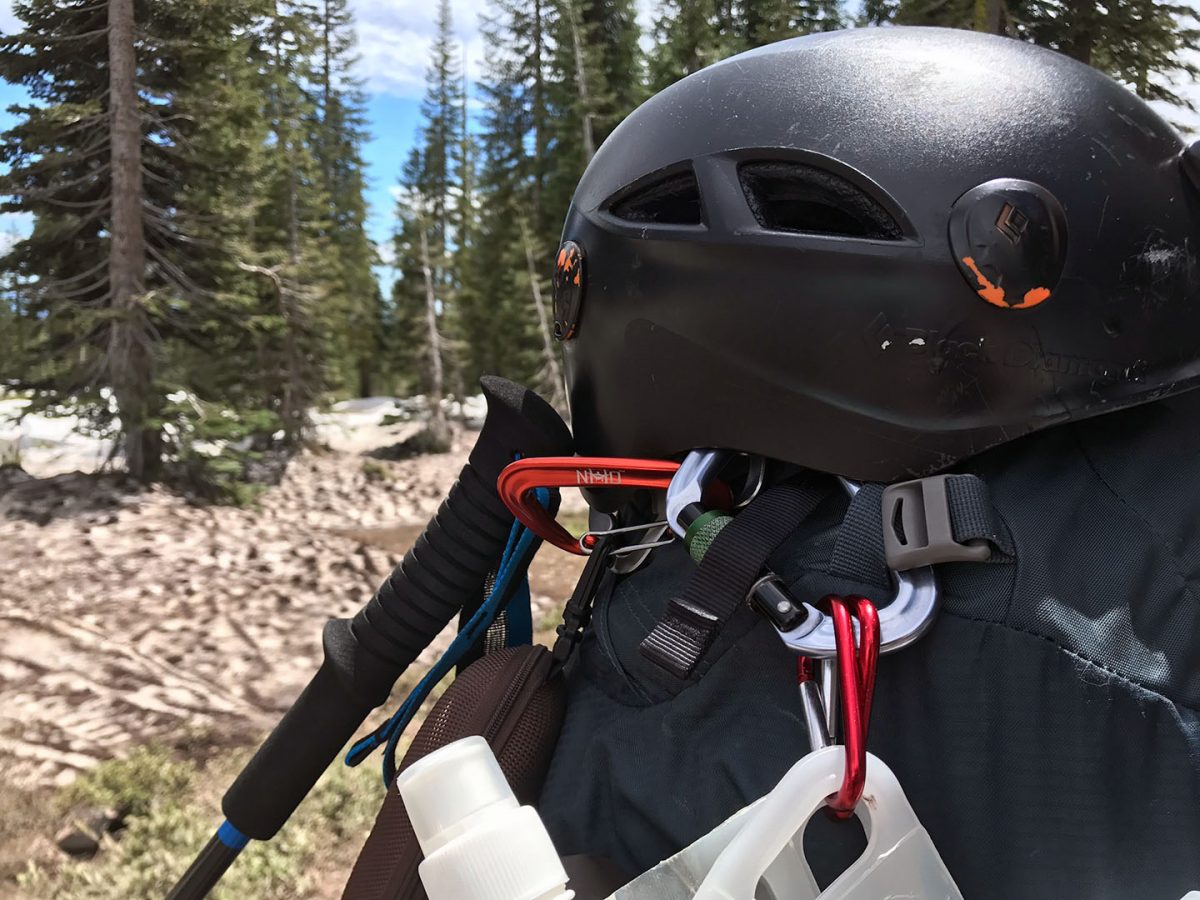
A climbing helmet is required on Mt. Shasta due to the potential for rock and ice fall on the Avalanche Gulch route. Your helmet should meet climbing certifications, meaning that it is rated for impact from above. Biking and ski helmets are not suitable substitutes as they are only rated for side impacts.
Blue Bags
Blue bags are provided for free at the climber check-in. They are used for solid waste disposal.
First Aid Kit
Each climber should carry a medical kit from which they can dispense first aid to themselves or another climber, but you should never depend on another climber to be able to patch you up. Adventure Medical sells a great, light-weight kit that we bring on every outdoor trip.
Overnight Gear
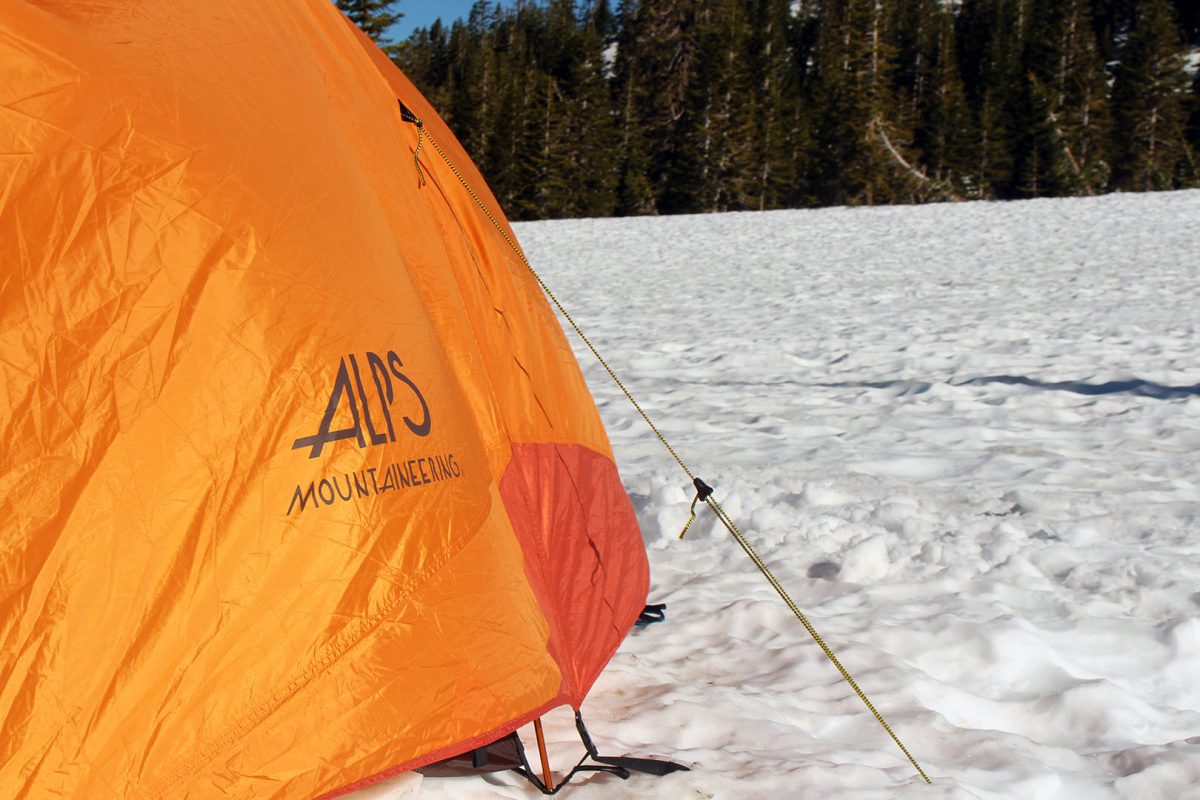
Most climbers plan their summit attempt as an overnight expedition. Picking the right overnight gear is important for a comfortable trip.
Tent / Shelter – A four season tent is recommended, however in good weather conditions a three season tent will pass. Despite it’s weight, we recommend the ALPS Mountaineering Tasmanian 3-Person Tent for it’s affordability while providing excellent protection on alpine terrain.
Sleeping Bag – A 0 – 20 degree bag will work under most conditions. The Marmot Sawtooth 15 degree sleeping bag is a great, lightweight bag which has proven to keep this climber warm on Mt. Shasta numerous times.
Sleeping Pad – Having an insulated sleeping pad is required in order to get your sleeping bag and body from being in contact with the snow and ice. Do not expect the tent floor to be sufficient thermal insulation even on a four season tent. The Therm-A-Rest ProLite sleeping pad does the job of giving you that extra insulating layer.
Stove
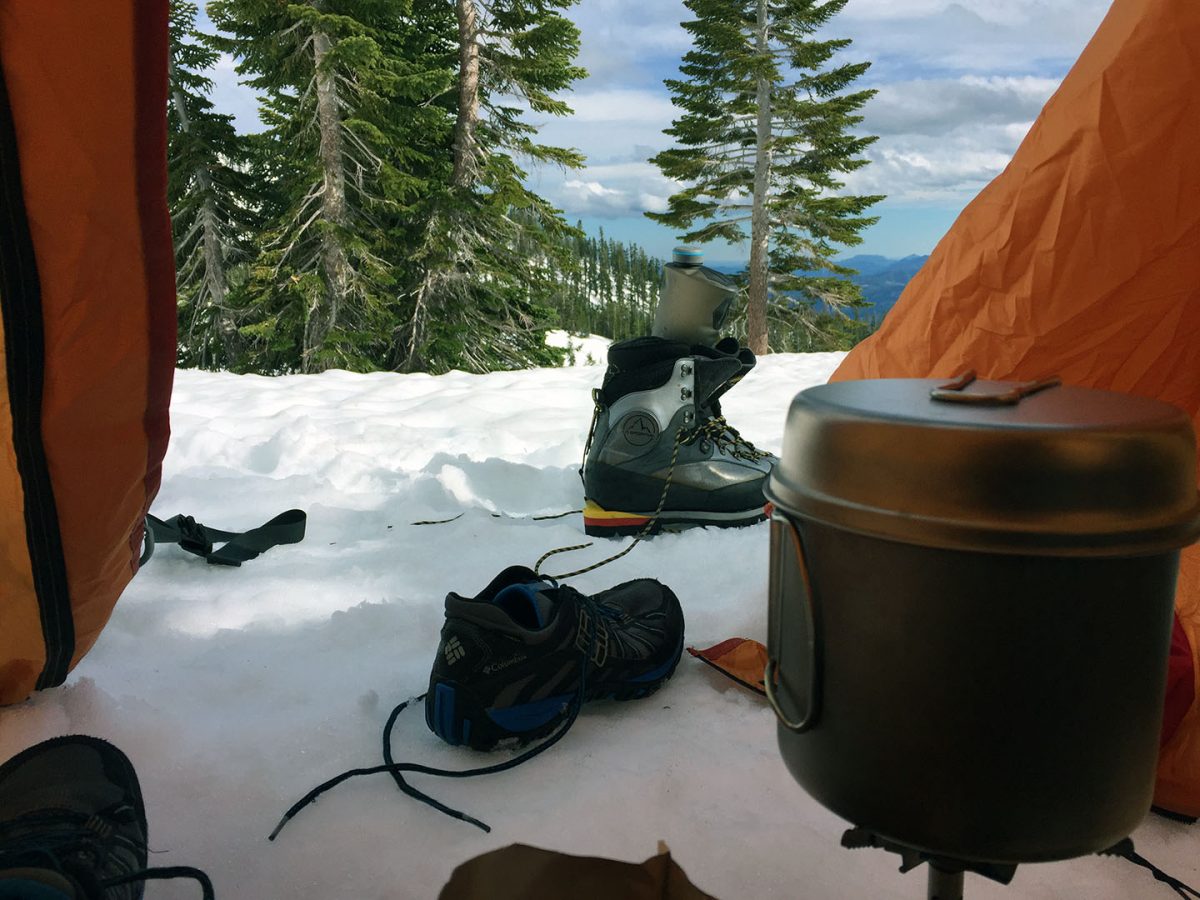
Portable stoves are useful for cooking warm meals and boiling water, but are invaluable in “creating” water by melting snow. Jetboil makes a great line of compact stove systems which we use on our trips.
Head Lamp
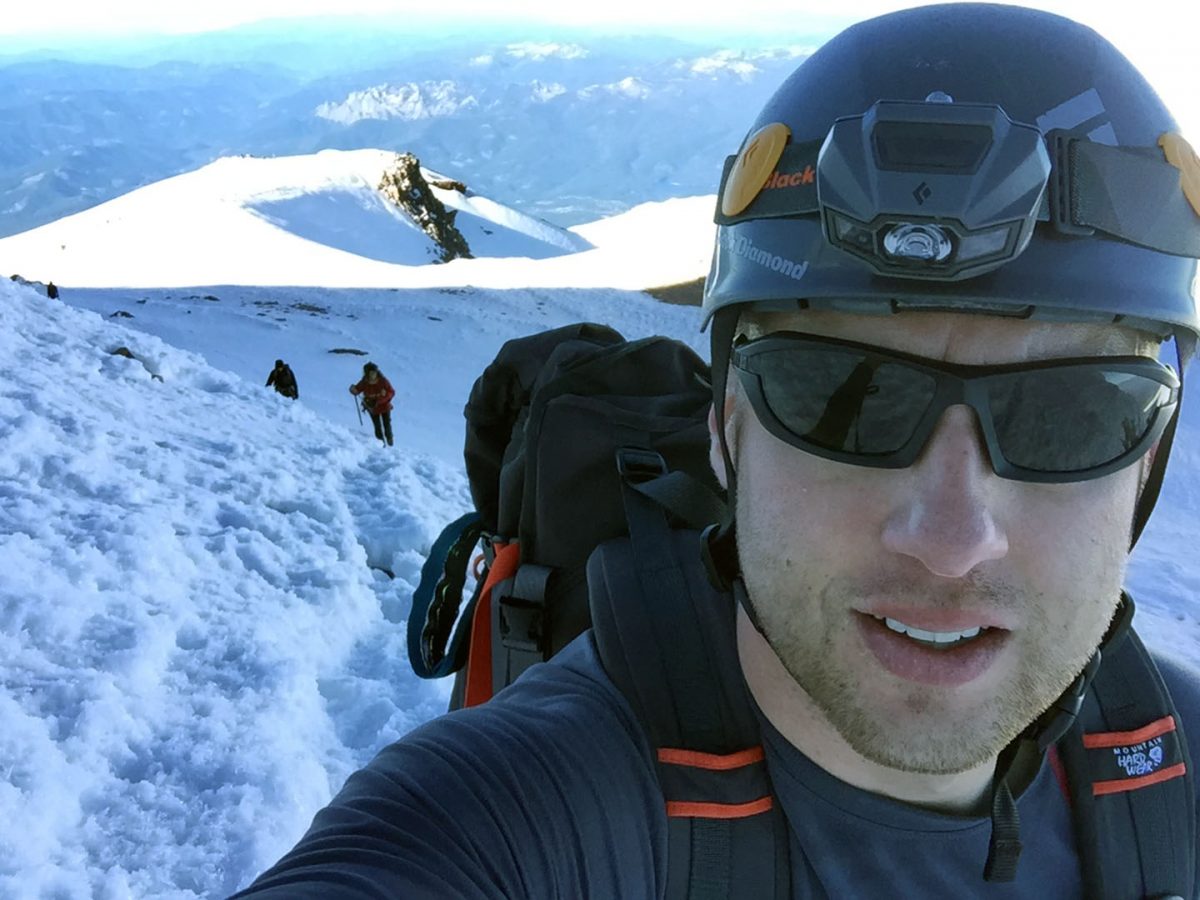
A headlamp with fresh batteries is highly recommended for an overnight climb of Mt. Shasta. Climbers getting an alpine start will be climbing Avalanche Gulch in the dark and having a bright light source is crucial to seeing where to place your feet. A headlamp is preferable to a handheld flashlight because climbers often want their hands free to use trekking poles or an ice ax.
Gaiters
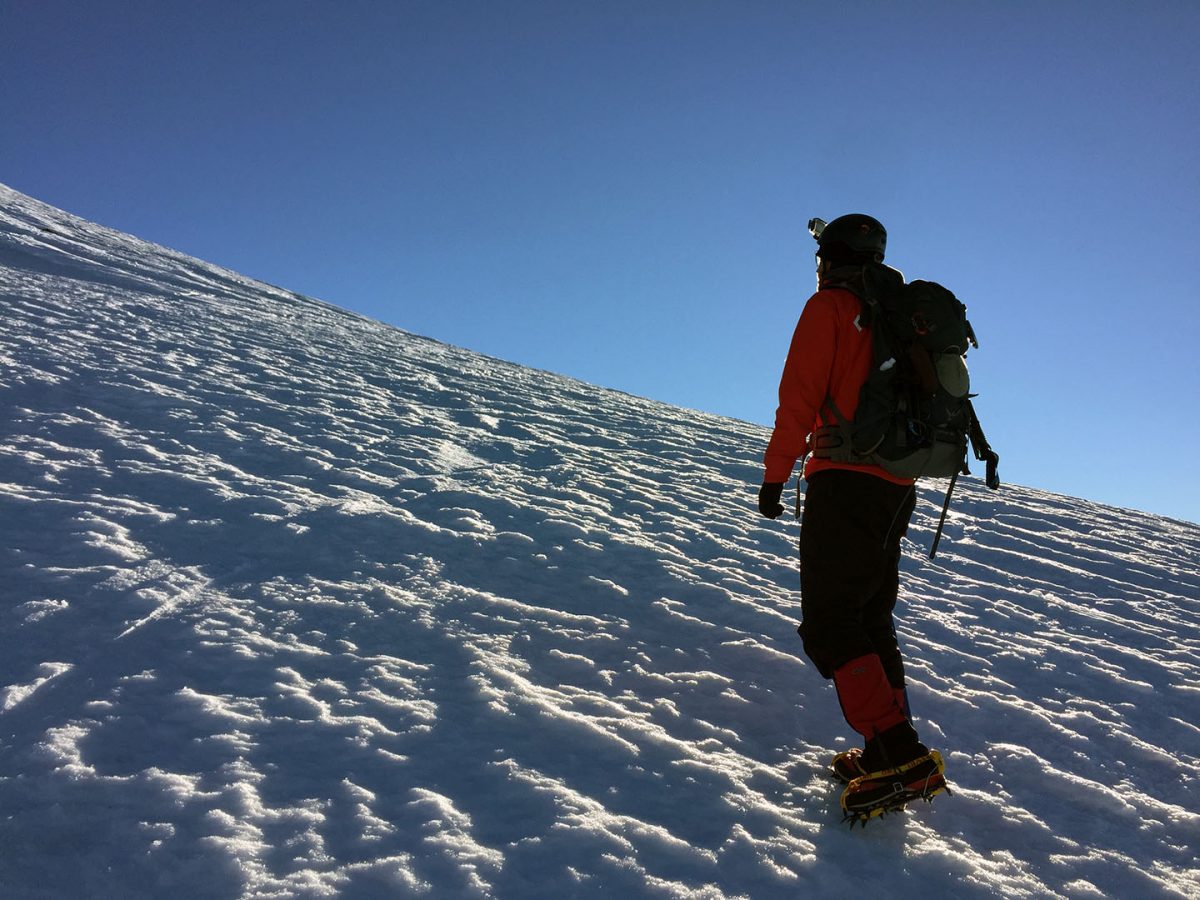
Gaiters cover the vulnerable tops of your footwear to fully protect your feet and lower legs from the snow, water, dirt and rocks that have a way of sneaking into even the best boots. While not strictly required for Mt. Shasta they can come in handy on the mountain in deep snow or in sections with a lot of loose scree. Even a less expensive product like Moutain Hardware or Outdoor Research
gaiters offer superb protection in most conditions.
Trekking Poles
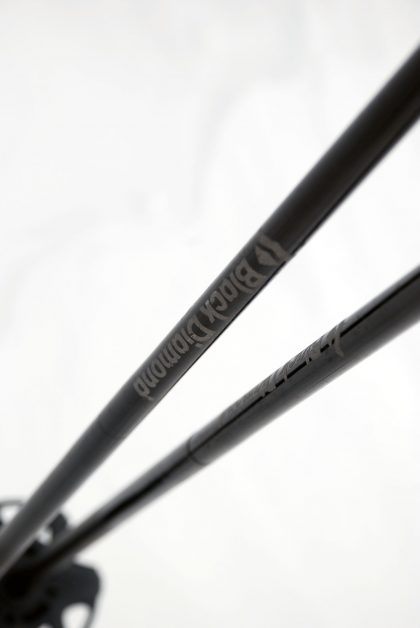
As we’ve lamented on other trips, trekking poles are extremely advantageous to have, especially on mountains. They do more than just provide stability. Trekking poles actually transfer load away from your legs. This is most noticeable on downhill sections where your knees are most likely to take a beating. An affordable pair of trekking poles will do the trick, however if you’re feeling the need to go ultra-light Black Diamond makes a carbon fiber trekking pole
. We like and have used both, but the Black Diamond product is mind-bendingly light and strong.
Navigation

Weather can change rapidly and white out conditions can descend on the mountain much quicker than you can climb down. Having and knowing how to use a map, compass, and altimeter can keep you on course.
Mobile Device
Most people will be carrying their cell phones when they climb so that they can snap photos of their adventure, but these devices can also serve as locators for lost climbers. In the days prior to wireless phone technology it was common to purchase or rent an avalanche transceiver or mountain locator unit (MLU) which could be used to locate a person in the event of an avalanche. More advanced devices like RECCO reflectors, PLBs, and SPOTS are now available which use GPS and two-way satellite communication to provide emergency personnel with more accurate information about your location.
Additional information about the advantages and disadvantages of these devices is available here.
Sun Protection
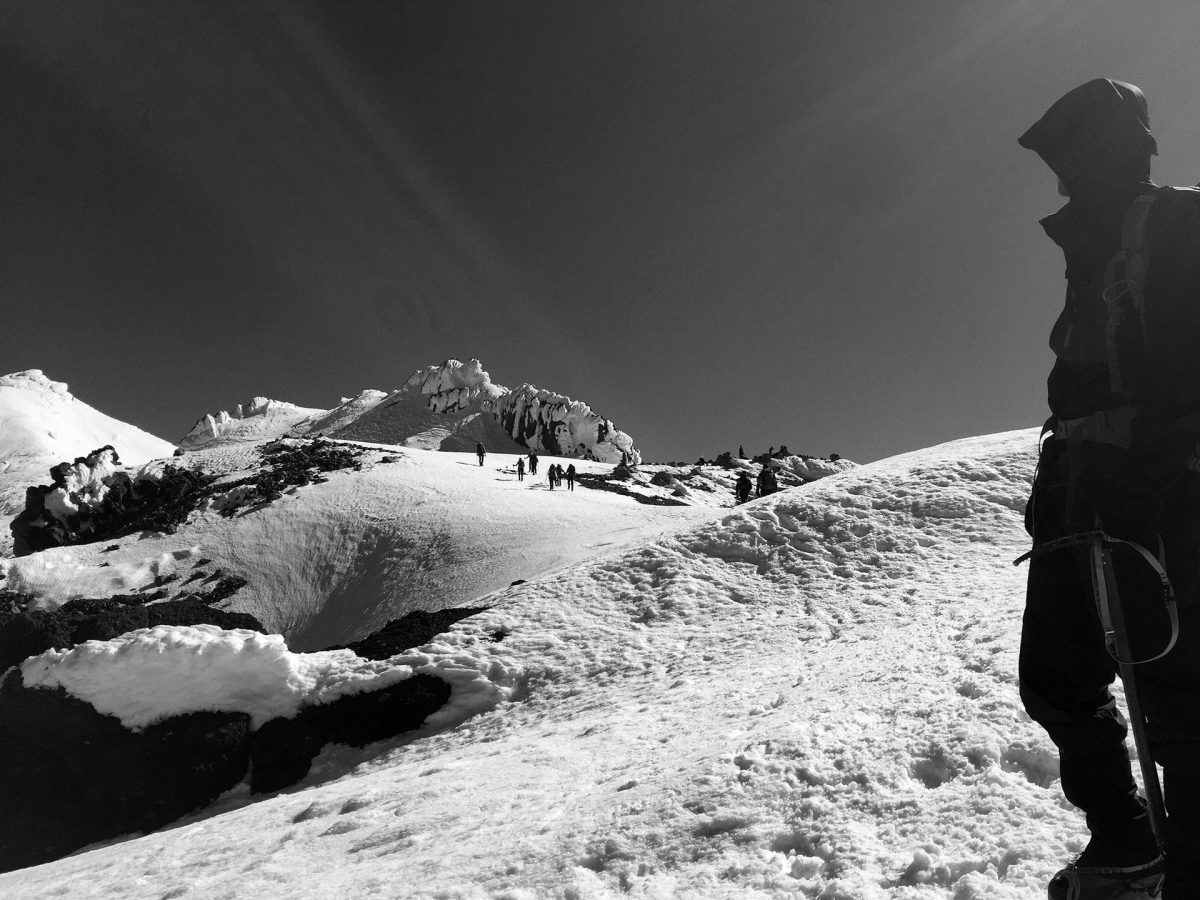
At elevation there is less atmosphere to protect your skin from the sun’s harmful radiation. Combine this with the reflective properties of snow and you can get a fairly severe sunburn without the proper protection. Having a strong sun screen (SPF 40+) or a hat that shades your neck, face, and ears can prevent this. It’s also easy to forget that your lips need protection too. Having lip balm with an SPF rating can go a long way to avoiding puffy, sun-burned lips. Wear sun glasses to protect your eyes as soon as the sun rises.
Avalanche Recovery Gear
Avalanches are less of a risk on this route than others on Mt. Shasta, despite the ominous name. While snow safety and avalanche awareness help reduce risk, climbers should carry specific items when the risk of an avalanche on Mt. Shasta is high:
- Avalanche beacon
– Each climber should be equipped with a beacon so that they can be discovered in the event of an avalanche. Many devices, like the Backcountry Access Tracker
, act as both a transmitter and a receiver- also known as a transceiver.
- Avalanche probe
– Similar in design to a trekking or tent pole, an avalanche probe is used to poke the snow to discover where a buried climber or object might be.
- Shovel
– Carrying a light-weight utility shovel allows you to dig other climbers out if they become trapped in an avalanche. We like the Yukon Charlie sport utility shovel
for its compact, componentized-designed, durability and light weight.
- Avalanche backpack
– Like a regular backpack except these contain airbags that, when triggered, inflates the airbags and helps you float on top of the avalanche to greatly reduce the probability of being buried.
Shovel
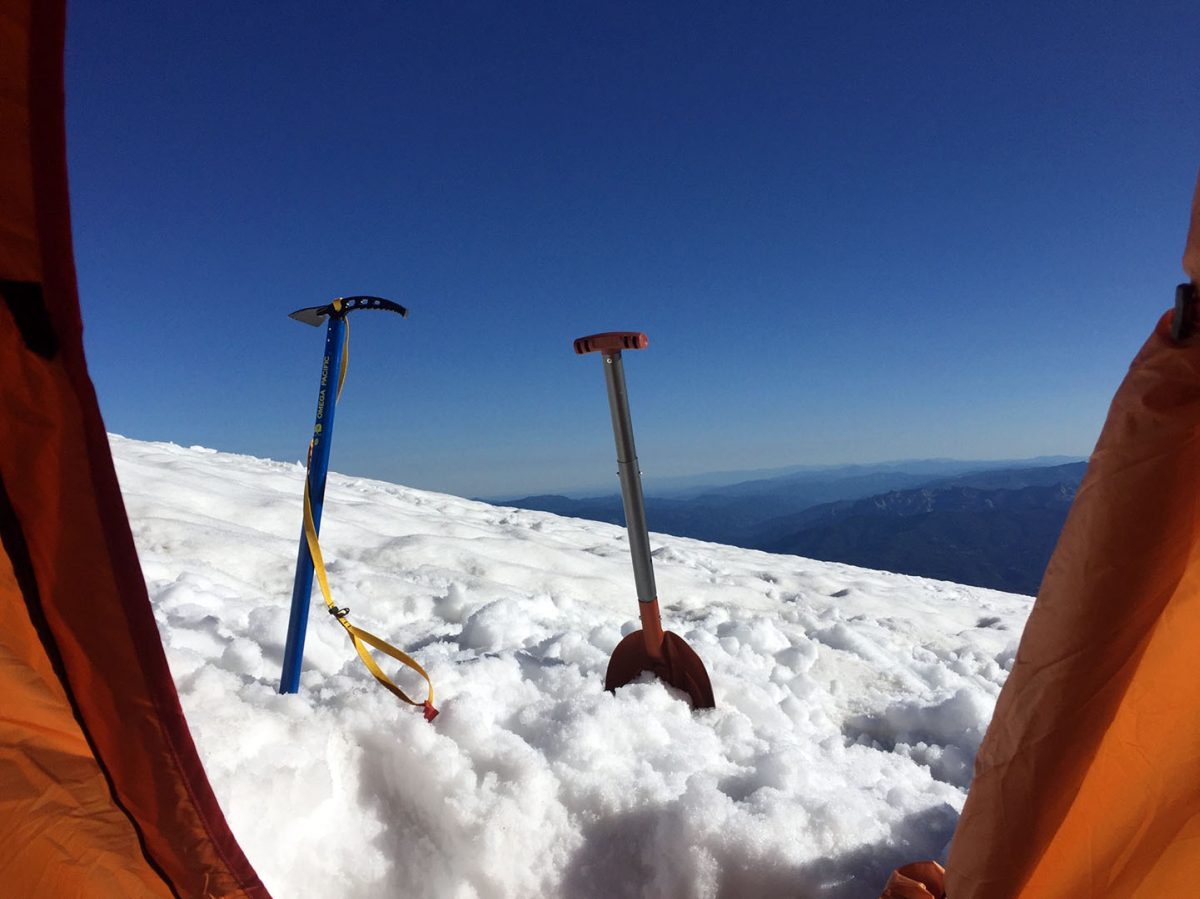
The primary reason for packing a light-weight shovel is to decrease risk of death during an avalanche. If someone in your party gets buried you only have a matter of minutes to find and dig them out before chances of survival plummet dramatically.
The secondary reason is to be able to dig yourself a snow cave in the event that bad weather moves in suddenly and you find yourself trapped on the side of the mountain. Here is a great reasonably priced, durable, light-weight, component shovelwhich we use.
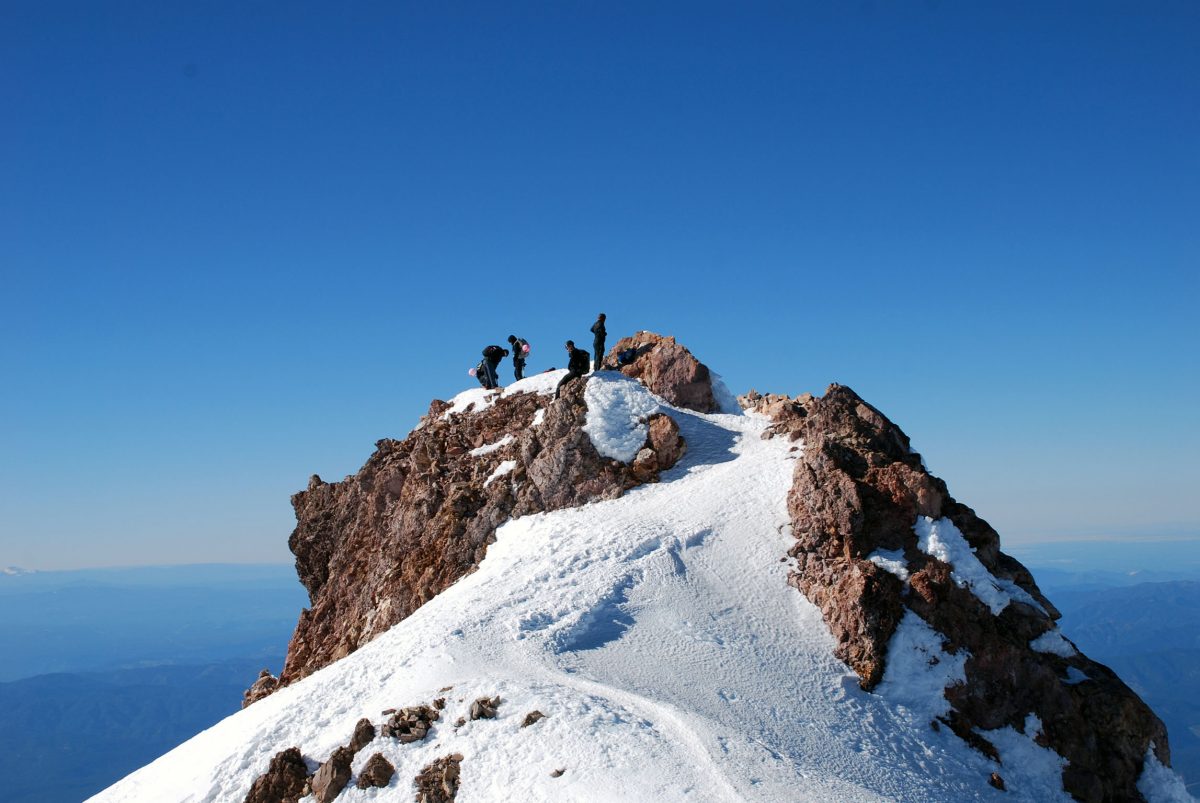
All climbers should have a plan in place for emergency situations. This includes a plan made with a friend or loved one who is NOT climbing, and a plan for the climber(s).
Friends/Family Plan: It is important that you leave an itinerary with a friend, family member or loved one who is not climbing. This way, should something happen and you are not able to initiate a search, rescuers will be alerted and a search will commence. This plan should include:
- The specific route you will take
- An alternate route in case of emergency
- Timetable for your climb
- A time when you will check in
- A time to initiate a search
- Contact information for Search and Rescue
- Contact information for family members of each climber
With this information in place, the individual you leave it with will know when to expect a phone call, when to worry, who to call and what to tell them. We recommend you pick a time you will check in with your friend/family member that is 1-3 hours after you plan on returning. This way you have flexibility for any delays. Your search initiation time should be 6-10 hours after you were suppose to check in. If you do use this kind of plan DO NOT FORGET TO CALL, even if you are off the mountain safely, call. If you are running late, call. If you blow off the climb and go to a bar, call.
Climber(s) Plan: Within your team, or as a solo climber, you must have a plan in case of emergency. It is impossible for us to go through every scenario, but you must work through some common problems and agree on the solutions before you leave. Questions you should consider are:
- What if a storm moves in?
- What if we get lost?
- What if we are behind schedule?
- What if the route conditions are questionable?
- What if someone is fatigued?
- What if someone is injured?
It is vital that every member of your group agree on an answer to these questions. During a climb, ego and adrenaline are high and decisions can be rash. Discuss possible scenarios before you leave and come to a consensus. These are problems best solved in the parking lot, or better yet the drive up. Of course, there are a million things that can happen in a million different ways. You must be able to asses the situation and make good judgements, often on the fly.
Avalanche Conditions
Mt Shasta
- Wikipedia.org – Mount Shasta
- USDA – So you want to climb Mount Shasta
- USDA – Visiting Mt. Shasta 2016
- SummitPost.org – Mount Shasta
- SummitPost.org – Avalanche Gulch
- ShastaAvalanche.org – Climbing Mt. Shasta FAQ
Bunny Flat Trailhead
- USDA – Mt Shasta Road Closures, Campground & Trail Information
- Shastavalanche.org – Bunny Flat Trailhead
Horse Camp
Avalanche Gulch
